Apple silicon
Apple silicon refers to a series of system on a chip (SoC) and system in a package (SiP) processors designed by Apple Inc., mainly using the ARM architecture. They are the basis of Mac, iPhone, iPad, Apple TV, Apple Watch, AirPods, AirTag, HomePod, and Apple Vision Pro devices.

| Mac transition to Apple silicon |
|---|
 |
Apple announced its plan to switch Mac computers from Intel processors to Apple silicon at WWDC 2020 on June 22, 2020.[1][2] The first Macs built with the Apple M1 chip were unveiled on November 10, 2020. As of June 2023, the entire Mac lineup uses Apple silicon chips.
Apple fully controls the integration of Apple silicon chips with the company's hardware and software products. Johny Srouji is in charge of Apple's silicon design.[3] Manufacturing of the chips is outsourced to semiconductor contract manufacturers such as TSMC.
A series
| Evolution of Apple "A" series | |||||||||||||||||||||||||||||||||||||||||||||||||||||||||||||||||||||||||||||||||||||||||||||||||||||||||||||||||||||||||||||||||||||||||||||||||||||||||||||||||||||||||||||||||||||||||||||||||||||||||||||||||||||||||||||||||||||||||||||||||||||||||||||||||||||||||||||||||||||||||||||||||||||||||||||||||||||||||||||||||||||||||||||||||||||||||||||||||||||||||||||||||||||||||||||||||||||||||||||||||||||||||||||||||||||||||||||||||||||||||||||||||||
|---|---|---|---|---|---|---|---|---|---|---|---|---|---|---|---|---|---|---|---|---|---|---|---|---|---|---|---|---|---|---|---|---|---|---|---|---|---|---|---|---|---|---|---|---|---|---|---|---|---|---|---|---|---|---|---|---|---|---|---|---|---|---|---|---|---|---|---|---|---|---|---|---|---|---|---|---|---|---|---|---|---|---|---|---|---|---|---|---|---|---|---|---|---|---|---|---|---|---|---|---|---|---|---|---|---|---|---|---|---|---|---|---|---|---|---|---|---|---|---|---|---|---|---|---|---|---|---|---|---|---|---|---|---|---|---|---|---|---|---|---|---|---|---|---|---|---|---|---|---|---|---|---|---|---|---|---|---|---|---|---|---|---|---|---|---|---|---|---|---|---|---|---|---|---|---|---|---|---|---|---|---|---|---|---|---|---|---|---|---|---|---|---|---|---|---|---|---|---|---|---|---|---|---|---|---|---|---|---|---|---|---|---|---|---|---|---|---|---|---|---|---|---|---|---|---|---|---|---|---|---|---|---|---|---|---|---|---|---|---|---|---|---|---|---|---|---|---|---|---|---|---|---|---|---|---|---|---|---|---|---|---|---|---|---|---|---|---|---|---|---|---|---|---|---|---|---|---|---|---|---|---|---|---|---|---|---|---|---|---|---|---|---|---|---|---|---|---|---|---|---|---|---|---|---|---|---|---|---|---|---|---|---|---|---|---|---|---|---|---|---|---|---|---|---|---|---|---|---|---|---|---|---|---|---|---|---|---|---|---|---|---|---|---|---|---|---|---|---|---|---|---|---|---|---|---|---|---|---|---|---|---|---|---|---|---|---|---|---|---|---|---|---|---|---|---|---|---|---|---|---|---|---|---|---|---|---|---|---|---|---|---|---|---|---|---|---|---|---|---|---|---|---|---|---|---|---|---|---|---|---|---|---|---|---|---|---|---|---|---|---|---|---|---|---|---|---|---|---|---|---|---|---|---|---|---|---|---|---|---|---|---|---|---|---|---|---|---|---|---|---|---|
| |||||||||||||||||||||||||||||||||||||||||||||||||||||||||||||||||||||||||||||||||||||||||||||||||||||||||||||||||||||||||||||||||||||||||||||||||||||||||||||||||||||||||||||||||||||||||||||||||||||||||||||||||||||||||||||||||||||||||||||||||||||||||||||||||||||||||||||||||||||||||||||||||||||||||||||||||||||||||||||||||||||||||||||||||||||||||||||||||||||||||||||||||||||||||||||||||||||||||||||||||||||||||||||||||||||||||||||||||||||||||||||||||||
The "A" series is a family of SoCs used in the iPhone, certain iPad models, and the Apple TV. "A" series chips were also used in the discontinued iPod Touch line and the original HomePod. They integrate one or more ARM-based processing cores (CPU), a graphics processing unit (GPU), cache memory and other electronics necessary to provide mobile computing functions within a single physical package.[4]
Apple A4
The Apple A4 is a PoP SoC manufactured by Samsung, the first SoC Apple designed in-house.[5] It combines an ARM Cortex-A8 CPU – also used in Samsung's S5PC110A01 SoC[6][7] – and a PowerVR SGX 535 graphics processor (GPU),[8][9][10] all built on Samsung's 45-nanometer silicon chip fabrication process.[11][12] The design emphasizes power efficiency.[13] The A4 commercially debuted in 2010, in Apple's iPad tablet,[8] and was later used in the iPhone 4 smartphone,[14] the fourth-generation iPod Touch, and the 2nd-generation Apple TV.[15]
The Cortex-A8 core used in the A4, dubbed "Hummingbird", is thought to use performance improvements developed by Samsung in collaboration with chip designer Intrinsity, which was subsequently acquired by Apple[16][17] It can run at far higher clock rates than other Cortex-A8 designs yet remains fully compatible with the design provided by ARM.[18] The A4 runs at different speeds in different products: 1 GHz in the first iPads,[19] 800 MHz in the iPhone 4 and fourth-generation iPod Touch, and an undisclosed speed in the 2nd-generation Apple TV.
The A4's SGX535 GPU could theoretically push 35 million polygons per second and 500 million pixels per second, although real-world performance may be considerably less.[20] Other performance improvements include additional L2 cache.
The A4 processor package does not contain RAM, but supports PoP installation. The 1st-generation iPad, fourth-generation iPod Touch,[21] and the 2nd-generation Apple TV[22] have an A4 mounted with two low-power 128 MB DDR SDRAM chips (totaling 256 MB), while the iPhone 4 has two 256 MB packages for a total of 512 MB.[23][24][25] The RAM is connected to the processor using ARM's 64-bit-wide AMBA 3 AXI bus. To give the iPad high graphics bandwidth, the width of the RAM data bus is double that used in previous ARM11- and ARM9-based Apple devices.[26]
Apple A5
The Apple A5 is an SoC manufactured by Samsung[27] that replaced the A4. The chip commercially debuted with the release of Apple's iPad 2 tablet in March 2011,[28] followed by its release in the iPhone 4S smartphone later that year. Compared to the A4, the A5 CPU "can do twice the work" and the GPU has "up to nine times the graphics performance",[29] according to Apple.
The A5 contains a dual-core ARM Cortex-A9 CPU[30] with ARM's advanced SIMD extension, marketed as NEON, and a dual core PowerVR SGX543MP2 GPU. This GPU can push between 70 and 80 million polygons/second and has a pixel fill rate of 2 billion pixels/second. The iPad 2's technical specifications page says the A5 is clocked at 1 GHz,[31] though it can adjust its frequency to save battery life.[30][32] The clock speed of the unit used in the iPhone 4S is 800 MHz. Like the A4, the A5 process size is 45 nm.[33]
An updated 32 nm version of the A5 processor was used in the 3rd-generation Apple TV, the fifth-generation iPod Touch, the iPad Mini, and the new version of iPad 2 (version iPad2,4).[34] The chip in the Apple TV has one core locked.[35][36] Markings on the square package indicate that it is named APL2498, and in software, the chip is called S5L8942. The 32 nm variant of the A5 provides around 15% better battery life during web browsing, 30% better when playing 3D games and about 20% better battery life during video playback.[37]
In March 2013, Apple released an updated version of the 3rd-generation Apple TV (Rev A, model A1469) containing a smaller, single-core version of the A5 processor. Unlike the other A5 variants, this version of the A5 is not a PoP, having no stacked RAM. The chip is very small, just 6.1×6.2 mm, but as the decrease in size is not due to a decrease in feature size (it is still on a 32 nm fabrication process), this indicates that this A5 revision is of a new design.[38] Markings tell that it is named APL7498, and in software, the chip is called S5L8947.[39][40]
Apple A5X
The Apple A5X is an SoC announced on March 7, 2012, at the launch of the third-generation iPad. It is a high-performance variant of the Apple A5; Apple claims it has twice the graphics performance of the A5.[41] It was superseded in the fourth-generation iPad by the Apple A6X processor.
The A5X has a quad-core graphics unit (PowerVR SGX543MP4) instead of the previous dual-core as well as a quad-channel memory controller that provides a memory bandwidth of 12.8 GB/s, roughly three times more than in the A5. The added graphics cores and extra memory channels add up to a very large die size of 165 mm²,[42] for example twice the size of Nvidia Tegra 3.[43] This is mainly due to the large PowerVR SGX543MP4 GPU. The clock frequency of the dual ARM Cortex-A9 cores have been shown to operate at the same 1 GHz frequency as in A5.[44] The RAM in A5X is separate from the main CPU package.[45]
Apple A6
The Apple A6 is a PoP SoC introduced on September 12, 2012, at the launch of the iPhone 5, then a year later was inherited by its minor successor the iPhone 5C. Apple states that it is up to twice as fast and has up to twice the graphics power compared to its predecessor the Apple A5.[46] It is 22% smaller and draws less power than the 45 nm A5.[47]
The A6 is said to use a 1.3 GHz[48] custom[49] Apple-designed ARMv7 based dual-core CPU, called Swift,[50] rather than a licensed CPU from ARM like in previous designs, and an integrated 266 MHz triple-core PowerVR SGX 543MP3[51] graphics processing unit (GPU). The Swift core in the A6 uses a new tweaked instruction set, ARMv7s, featuring some elements of the ARM Cortex-A15 such as support for the Advanced SIMD v2, and VFPv4.[49] The A6 is manufactured by Samsung on a high-κ metal gate (HKMG) 32 nm process.[52]
Apple A6X
Apple A6X is an SoC introduced at the launch of the fourth-generation iPad on October 23, 2012. It is a high-performance variant of the Apple A6. Apple claims the A6X has twice the CPU performance and up to twice the graphics performance of its predecessor, the Apple A5X.[53]
Like the A6, this SoC continues to use the dual-core Swift CPU, but it has a new quad core GPU, quad channel memory and slightly higher 1.4 GHz CPU clock rate.[54] It uses an integrated quad-core PowerVR SGX 554MP4 graphics processing unit (GPU) running at 300 MHz and a quad-channel memory subsystem.[54][55] Compared to the A6 the A6X is 30% larger, but it continues to be manufactured by Samsung on a high-κ metal gate (HKMG) 32 nm process.[55]
Apple A7
The Apple A7 is a 64-bit PoP SoC whose first appearance was in the iPhone 5S, which was introduced on September 10, 2013. The chip would also be used in the iPad Air, iPad Mini 2 and iPad Mini 3. Apple states that it is up to twice as fast and has up to twice the graphics power compared to its predecessor the Apple A6.[56] The Apple A7 chip is the first 64-bit chip to be used in a smartphone and later a tablet computer.[57]
The A7 features an Apple-designed 1.3[58]–1.4[59] GHz 64-bit[60] ARMv8-A[61][62] dual-core CPU,[58] called Cyclone,[61] and an integrated PowerVR G6430 GPU in a four cluster configuration.[63] The ARMv8-A architecture doubles the number of registers of the A7 compared to the A6.[64] It now has 31 general-purpose registers that are each 64-bits wide and 32 floating-point/NEON registers that are each 128-bits wide.[60] The A7 is manufactured by Samsung on a high-κ metal gate (HKMG) 28 nm process[65] and the chip includes over 1 billion transistors on a die 102 mm2 in size.[58]
Apple A8
The Apple A8 is a 64-bit PoP SoC manufactured by TSMC. Its first appearance was in the iPhone 6 and iPhone 6 Plus, which were introduced on September 9, 2014.[66] A year later it would drive the iPad Mini 4. Apple states that it has 25% more CPU performance and 50% more graphics performance while drawing only 50% of the power compared to its predecessor, the Apple A7.[67] On February 9, 2018, Apple released the HomePod, which is powered by an Apple A8 with 1 GB of RAM.[68]
The A8 features an Apple-designed 1.4[69] GHz 64-bit[70] ARMv8-A[70] dual-core CPU, and an integrated custom PowerVR GX6450 GPU in a four cluster configuration.[69] The GPU features custom shader cores and compiler.[71] The A8 is manufactured on a 20 nm process[72] by TSMC,[73] which replaced Samsung as the manufacturer of Apple's mobile device processors. It contains 2 billion transistors. Despite that being double the number of transistors compared to the A7, its physical size has been reduced by 13% to 89 mm2 (consistent with a shrink only, not known to be a new microarchitecture).[74]
Apple A8X
The Apple A8X is a 64-bit SoC introduced at the launch of the iPad Air 2 on October 16, 2014.[75] It is a high performance variant of the Apple A8. Apple states that it has 40% more CPU performance and 2.5 times the graphics performance of its predecessor, the Apple A7.[75][76]
Unlike the A8, this SoC uses a triple-core CPU, a new octa-core GPU, dual channel memory and slightly higher 1.5 GHz CPU clock rate.[77] It uses an integrated custom octa-core PowerVR GXA6850 graphics processing unit (GPU) running at 450 MHz and a dual-channel memory subsystem.[77] It is manufactured by TSMC on their 20 nm fabrication process, and consists of 3 billion transistors.
Apple A9
The Apple A9 is a 64-bit ARM-based SoC that first appeared in the iPhone 6S and 6S Plus, which were introduced on September 9, 2015.[78] Apple states that it has 70% more CPU performance and 90% more graphics performance compared to its predecessor, the Apple A8.[78] It is dual sourced, a first for an Apple SoC; it is manufactured by Samsung on their 14 nm FinFET LPE process and by TSMC on their 16 nm FinFET process. It was subsequently included in the first-generation iPhone SE, and the iPad (5th generation). The Apple A9 was the last CPU that Apple manufactured through a contract with Samsung, as all A-series chips after are manufactured by TSMC.
Apple A9X
The Apple A9X is a 64-bit SoC that was announced on September 9, 2015, and released on November 11, 2015, and first appeared in the iPad Pro.[79] It offers 80% more CPU performance and two times the GPU performance of its predecessor, the Apple A8X. It is manufactured by TSMC using a 16 nm FinFET process.[80]
Apple A10 Fusion
The Apple A10 Fusion is a 64-bit ARM-based SoC that first appeared in the iPhone 7 and 7 Plus, which were introduced on September 7, 2016.[81] The A10 is also featured in the sixth-generation iPad, seventh-generation iPad and seventh-generation iPod Touch.[82] It has a new ARM big.LITTLE quad core design with two high performance cores, and two smaller highly efficient cores. It is 40% faster than the A9, with 50% faster graphics. It is manufactured by TSMC on their 16 nm FinFET process.
Apple A10X Fusion
The Apple A10X Fusion is a 64-bit ARM-based SoC that first appeared in the 10.5" iPad Pro and the second generation of the 12.9" iPad Pro, which were both announced on June 5, 2017.[83] It is a variant of the A10 and Apple claims that it has 30 percent faster CPU performance and 40 percent faster GPU performance than its predecessor, the A9X.[83] On September 12, 2017, Apple announced that the Apple TV 4K would be powered by an A10X chip. It is made by TSMC on their 10 nm FinFET process.[84]
Apple A11 Bionic
The Apple A11 Bionic is a 64-bit ARM-based SoC[85] that first appeared in the iPhone 8, iPhone 8 Plus, and iPhone X, which were introduced on September 12, 2017.[85] It has two high-performance cores, which are 25% faster than the A10 Fusion, four high-efficiency cores, which are 70% faster than the energy-efficient cores in the A10, and for the first time an Apple-designed three-core GPU with 30% faster graphics performance than the A10.[85][86] It is also the first A-series chip to feature Apple's "Neural Engine," which enhances artificial intelligence and machine learning processes.[87]
Apple A12 Bionic
The Apple A12 Bionic is a 64-bit ARM-based SoC that first appeared in the iPhone XS, XS Max and XR, which were introduced on September 12, 2018. It is also used in the third-generation iPad Air, fifth-generation iPad Mini, and the eighth-generation iPad. It has two high-performance cores, which are 15% faster than the A11 Bionic, and four high-efficiency cores, which have 50% lower power usage than the energy-efficient cores in the A11 Bionic.[88] The A12 is manufactured by TSMC[89] using a 7 nm[90] FinFET process, the first to ship in a smartphone.[91][89] It is also used in the 6th generation Apple TV.
Apple A12X Bionic
The Apple A12X Bionic is a 64-bit ARM-based SoC that first appeared in the 11.0" iPad Pro and the third generation of the 12.9" iPad Pro, which were both announced on October 30, 2018.[92] It offers 35% faster single-core and 90% faster multi-core CPU performance than its predecessor, the A10X. It has four high-performance cores and four high-efficiency cores. The A12X is manufactured by TSMC using a 7 nm FinFET process.
Apple A12Z Bionic
The Apple A12Z Bionic is an updated version of the A12X Bionic, first appearing in the fourth generation iPad Pro, which was announced on March 18, 2020.[93] It adds an additional GPU core, compared to the A12X, for improved graphics performance.[94] The A12Z is also used in the Developer Transition Kit prototype computer that helps developers prepare their software for Macs based on Apple silicon.[95]
Apple A13 Bionic
The Apple A13 Bionic is a 64-bit ARM-based SoC that first appeared in the iPhone 11, 11 Pro, and 11 Pro Max, which were introduced on September 10, 2019. It is also featured in the second-generation iPhone SE (released April 15, 2020), the 9th generation iPad (announced September 14, 2021) and in the Studio Display (announced March 8, 2022)
The entire A13 SoC features a total of 18 cores – a six-core CPU, four-core GPU, and an eight-core Neural Engine processor, which is dedicated to handling on-board machine learning processes; four of the six cores on the CPU are low-powered cores that are dedicated to handling less CPU-intensive operations, such as voice calls, browsing the Web, and sending messages, while two higher-performance cores are used only for more CPU-intensive processes, such as recording 4K video or playing a video game.[96]
Apple A14 Bionic
The Apple A14 Bionic is a 64-bit ARM-based SoC that first appeared in the fourth-generation iPad Air and iPhone 12, released on October 23, 2020. It is the first commercially available 5 nm chipset and it contains 11.8 billion transistors and a 16-core AI processor.[97] It includes Samsung LPDDR4X DRAM, a 6-core CPU, and 4-Core GPU with real time machine learning capabilities. It was later used in the tenth-generation iPad, released on October 26, 2022.
Apple A15 Bionic
The Apple A15 Bionic is a 64-bit ARM-based SoC that first appeared in the iPhone 13, unveiled on September 14, 2021. The A15 is built on a 5-nanometer manufacturing process with 15 billion transistors. It has 2 high-performance processing cores, 4 high-efficiency cores, a new 5-core graphics for iPhone 13 Pro series (4-core for iPhone 13 and 13 mini) processing unit, and a new 16-core Neural Engine capable of 15.8 trillion operations per second.[98][99] It is also used in the iPhone SE (3rd generation), iPhone 14, iPhone 14 Plus and iPad Mini 6.[100]
Apple A16 Bionic
The Apple A16 Bionic is a 64-bit ARM-based SoC that first appeared in the iPhone 14 Pro, unveiled on September 7, 2022. The A16 has 16 billion transistors and is built on TSMC's N4P fabrication process, being touted by Apple as the first 4 nm processor in a smartphone.[101][102] However, N4 is an enhanced version of N5 technology, a de facto fourth-generation 5 nm manufacturing process.[103][104][105] The chip has 2 high-performance processing cores, 4 high-efficiency cores and 5-core graphics for iPhone 14 Pro series. Memory is upgraded to LPDDR5 for 50% higher bandwidth and a 7% faster 16-core Neural Engine capable of 17 trillion operations per second.
Apple A17 Pro
The Apple A17 Pro is a 64-bit ARM-based SoC that first appeared in the iPhone 15 Pro, unveiled on September 12, 2023. It is Apple's first 3nm SoC. The chip has 2 high-performance processing cores, 4 high-efficiency cores, a 6-core GPU for iPhone 15 Pro series, and a 16-core Neural Engine capable of 35 trillion operations per second. The GPU was described as their biggest redesign in the history of Apple GPUs, it added hardware accelerated Ray tracing and mesh shading support.[106]
List of processors
| General | Image | Semiconductor technology | Computer architecture | CPU | GPU | AI accelerator | Memory technology | First released date | Devices | Supported OS | |||||||||||||||||||||||||||
|---|---|---|---|---|---|---|---|---|---|---|---|---|---|---|---|---|---|---|---|---|---|---|---|---|---|---|---|---|---|---|---|---|---|---|---|---|---|
| Name | Codename | Part No. | Node | Manufacturer | Transistors count | Die size | CPU ISA | Bit width | Performance core | Efficiency core | Overall cores | Cache | Vendor | Cores | SIMD EU count | FP32 ALU count | Frequency | FP32 FLOPS | Cores | OPS | Memory bus width | Total channel Bit per channel |
Memory type | Theoretical bandwidth |
Available capacity | Initial | Terminal | ||||||||||
| Core name | Cores | Core speed | Core name | Cores | Core speed | L1 | L2 | L3 | SLC | ||||||||||||||||||||||||||||
| [lower-alpha 1] | APL0098 | S5L8900 | 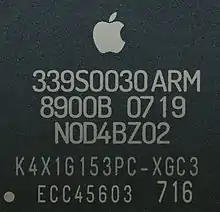 |
90 nm [107] |
Samsung | 72 mm2 [11] |
ARMv6 | 32-bit | ARM11 | 1 | 412 MHz | — | — | — | Single-core | L1i: 16 KB L1d: 16 KB |
— | — | — | PowerVR MBX Lite |
1 | 1 | 8 | 60 MHz – 103 MHz | 0.96 GFLOPS – 1.64 GFLOPS | — | — | 16-bit | 1 channel 16-bit/channel |
LPDDR-266 (133.25 MHz) |
533 MB/s | 128 MB | June 29, 2007 | iPhone iPod Touch (1st Gen) |
iPhone OS 1.0 | ||
| [lower-alpha 2] | APL0278 | S5L8720 |  |
65 nm [11] |
36 mm2 [11] |
533 MHz | 103 MHz – 133 MHz | 1.64 GFLOPs – 2.12 GFLOPS | 32-bit | 1 channel 32-bit/channel |
1066 MB/s | July 11, 2008 | iPhone 3G iPod Touch (2nd Gen) |
iPhone OS 2.1.1 | |||||||||||||||||||||||
| [lower-alpha 3] | APL0298 | S5L8920 |  |
71.8 mm2 [12] |
ARMv7 | Cortex-A8 | 600 MHz | L1i: 32 KB L1d: 32 KB |
256 KB | PowerVR SGX535 [108] |
2 | 16 | 200 MHz | 6.4 GFLOPS | LPDDR-400 (200 MHz) |
1.6 GB/s | 256 MB | June 19, 2009 | iPhone 3GS | iPhone OS 3.0 | iOS 6.1.6 | ||||||||||||||||
| APL2298 | S5L8922 |  |
45 nm [11][12] [33] |
41.6 mm2 [11] |
September 9, 2009 | iPod Touch (3rd Gen) | iPhone OS 3.1.1 | iOS 5.1.1 | |||||||||||||||||||||||||||||
| A4 | APL0398 | S5L8930 | 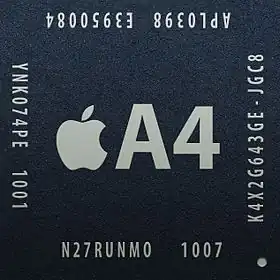 |
53.3 mm2 [11][12] |
800 MHz | 512 KB | 200 MHz – 250 MHz | 6.4 GFLOPS – 8.0 GFLOPS | 64-bit | 2 channels 32-bit/channel |
3.2 GB/s | April 3, 2010 | iPad (1st Gen) iPhone 4 iPod Touch (4th Gen) Apple TV (2nd Gen) |
iPhone OS 3.2 Apple TV Software 4.0 |
iOS 6.1.6 | ||||||||||||||||||||||
| 1.0 GHz | iOS 5.1.1[lower-alpha 4] Apple TV Software 6.2.1 | ||||||||||||||||||||||||||||||||||||
| 800 MHz | 512 MB | iOS 7.1.2 | |||||||||||||||||||||||||||||||||||
| A5 | APL0498 | S5L8940 |  |
122.2 mm2 [33] |
Cortex-A9 | 2 | 800 MHz | Dual-core | 1 MB | PowerVR SGX543 [109][51] |
2 | 4 | 32 | 200 MHz | 12.8 GFLOPS | LPDDR2-800 (400 MHz) |
6.4 GB/s | March 11, 2011 | iPad 2 iPhone 4S |
iOS 4.3 | iOS 9.3.5[lower-alpha 5] iOS 9.3.6[lower-alpha 6] Apple TV Software 7.6.2 | ||||||||||||||||
| 1.0 GHz | |||||||||||||||||||||||||||||||||||||
| APL2498 | S5L8942 | 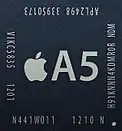 |
32 nm Hκ MG [34][40] |
69.6 mm2 [34] |
800 MHz | March 7, 2012 | Apple TV (3nd Gen) iPad 2 iPod Touch (5th Gen) iPad Mini (1st Gen) |
iOS 5.1 | |||||||||||||||||||||||||||||
| 1.0 GHz | |||||||||||||||||||||||||||||||||||||
| 2 (One core locked) | Dual-core Single-core in actual |
Apple TV Software 5.0 | |||||||||||||||||||||||||||||||||||
| APL7498 | S5L8947 |  |
37.8 mm2 [40] |
1 | Single-core | January 28, 2013 | Apple TV (3nd Gen Rev. A) | Apple TV Software 5.2 | |||||||||||||||||||||||||||||
| A5X | APL5498 | S5L8945 |  |
45 nm [11][12] [33] |
165 mm2 [42] |
2 | Dual-core | 4 | 8 | 64 | 25.6 GFLOPS | 128-bit | 4 channels 32-bit/channel |
12.8 GB/s | 1 GB | March 16, 2012 | iPad (3rd Gen) | iOS 5.1 | |||||||||||||||||||
| A6 | APL0598 | S5L8950 | 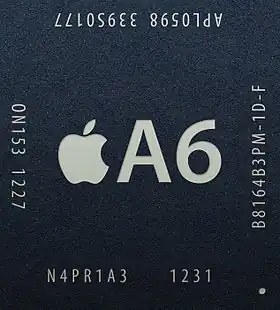 |
32 nm Hκ MG [52][110] [55] |
96.71 mm2 [52][110] |
ARMv7s[111] | Swift[49] | 1.3 GHz [112] |
3 | 6 | 48 | 266 or 709 MHz | 25.5 or 68.0 GFLOPS | 64-bit | 2 channels 32-bit/channel |
LPDDR2-1066 (533 MHz) |
8.5 GB/s | September 21, 2012 | iPhone 5 iPhone 5C |
iOS 6.0 | iOS 10.3.3[lower-alpha 7] iOS 10.3.4[lower-alpha 8] | ||||||||||||||||
| A6X | APL5598 | S5L8955 | 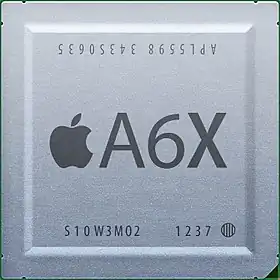 |
123 mm2 [55] |
1.4 GHz [54] |
PowerVR SGX554 [54][113] |
4 | 16 | 128 | 300 MHz | 76.8 GFLOPS | 128-bit | 4 channels 32-bit/channel |
17.0 GB/s | November 2, 2012 | iPad (4th Gen) | |||||||||||||||||||||
| A7 | APL0698 | S5L8960 | 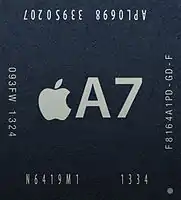 |
28 nm Hκ MG [65][114] |
1 billion | 102 mm2 [60][114] |
ARMv8.0-A [61][69] |
64-bit | Cyclone | 1.3 GHz | L1i: 64 KB L1d: 64 KB |
4 MB (Inclusive) [61][115][59] |
PowerVR G6430 [63][113] |
450 MHz | 115.2 GFLOPS | 64-bit | 1 channel 64-bit/channel |
LPDDR3-1600 (800 MHz) |
12.8 GB/s | September 20, 2013 | iPhone 5S iPad Mini 2 iPad Mini 3 |
iOS 7.0 | iOS 12.5.7 | ||||||||||||||
| APL5698 | S5L8965 | 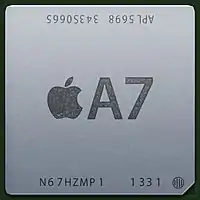 |
1.4 GHz | November 1, 2013 | iPad Air (1st Gen) | iOS 7.0.3 | |||||||||||||||||||||||||||||||
| A8 | APL1011 | T7000 | 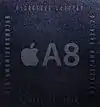 |
20 nm Hκ MG [70][69] |
TSMC | 2 billion | 89 mm2 [116][77] [117] |
Typhoon | 1.1 GHz | PowerVR GX6450 [71][118][119] |
533 MHz | 136.4 GFLOPS | September 19, 2014 | iPhone 6 & 6 Plus iPod Touch (6th Gen) iPad Mini 4 Apple TV HD HomePod (1st Gen) |
iOS 8.0 | ||||||||||||||||||||||
| 1.4 GHz | |||||||||||||||||||||||||||||||||||||
| audioOS 11.0 | HomePod Software 15.6 (Current) | ||||||||||||||||||||||||||||||||||||
| 1.5 GHz | 2 GB | iOS 8.0 tvOS 9.0 |
iPadOS 15.8 (Current) tvOS 17.1 (Current) | ||||||||||||||||||||||||||||||||||
| A8X | APL1021 | T7001 |  |
3 billion | 128 mm2 [77] |
3 | 1.5 GHz | 3-core | 2 MB | PowerVR GX6850 [71][77][117] |
8 | 32 | 256 | 450 MHz | 230.4 GFLOPS | 128-bit | 2 channels 64-bit/channel |
25.6 GB/s | October 22, 2014 | iPad Air 2 | iOS 8.1 | iPadOS 15.8 (Current) | |||||||||||||||
| A9 | APL0898 | S8000 | 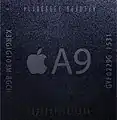 |
14 nm FinFET [120] |
Samsung | ≥ 2 billion | 96 mm2 [121] |
Twister | 2 | 1.85 GHz [122][123] |
Dual-core | 3 MB | 4 MB (Victim) | PowerVR GT7600 [71][125] |
6 | 24 | 192 | 650 MHz | 249.6 GFLOPS | 64-bit | 1 channel 64-bit/channel |
LPDDR4-3200 (1600 MHz) |
September 25, 2015 | iPhone 6S & 6S Plus iPhone SE (1st Gen) iPad (5th Gen) |
iOS 9.0 | iOS 15.8 (Current) iPadOS 16.7.2 (Current) tvOS 17.1 (Current) | |||||||||||
| APL1022 | S8003 | 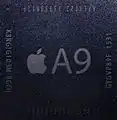 |
16 nm FinFET [121][126] [127] |
TSMC | 104.5 mm2 [121] | ||||||||||||||||||||||||||||||||
| A9X | APL1021 | S8001 |  |
≥ 3 billion | 143.9 mm2 [126][84] |
2.16 GHz [128][129] |
— [115][126] |
PowerVR GT7850 [71][126] |
12 | 48 | 384 | 499.2 GFLOPS | 128-bit (64-bit in actual) |
2 channels (one channel is unused) 64-bit/channel |
November 11, 2015 | iPad Pro 9.7-inch (2016) & iPad Pro 12.9-inch (2015) | iOS 9.1 | ||||||||||||||||||||
| 2.26 GHz | 128-bit | 2 channels 64-bit/channel |
51.2 GB/s | 4 GB | |||||||||||||||||||||||||||||||||
| A10 Fusion | APL1W24 | T8010 | 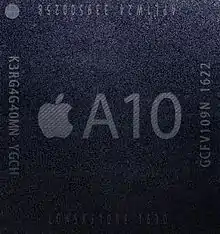 |
3.3 billion | 125 mm2 [127] |
ARMv8.1-A | Hurricane | 2 | 1.64 GHz | Zephyr | 2 | 1.09 GHz | Quad-core (Only 2 cores performed at a same time) |
P-core: L1i: 64 KB L1d: 64 KB E-core: L1i: 32 KB L1d: 32KB |
P-core: 3 MB E-core: 1 MB |
4 MB | PowerVR GT7600 Plus[130][71] [131][132] |
6 | 24 | 192 | 900 MHz | 345.6 GFLOPS | 64-bit | 1 channel 64-bit/channel |
25.6 GB/s | 2 GB | September 16, 2016 | iPhone 7 & 7 Plus iPad (6th Gen) iPad (7th Gen) iPod Touch (7th gen) |
iOS 10.0 | ||||||||
| 2.34 GHz | |||||||||||||||||||||||||||||||||||||
| 3 GB | |||||||||||||||||||||||||||||||||||||
| A10X Fusion | APL1071 | T8011 | 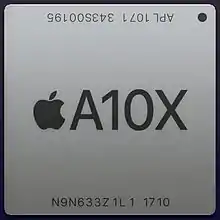 |
10 nm FinFET [84] |
≥ 4 billion | 96.4 mm2 [84] |
3 | 2.38 GHz | 3 | 1.30 GHz | 6-core (Only 3 cores performed at a same time) |
P-core: 8 MB E-core: 1 MB |
— [133][134] |
4 MB | 12 | 48 | 384 | 1000 MHz | 768.0 GFLOPS | 128-bit | 2 channels 64-bit/channel |
51.2 GB/s | 3 GB | June 13, 2017 | iPad Pro 10.5-inch (2017) & iPad Pro 12.9-inch (2nd Gen) Apple TV 4K (2017) |
tvOS 11.0 | |||||||||||
| 4 GB | iOS 10.3.2 | ||||||||||||||||||||||||||||||||||||
| A11 Bionic |
APL1W72 | T8015 | 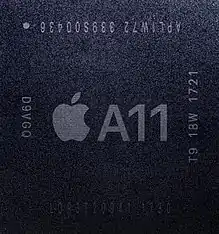 |
4.3 billion | 87.66 mm2 [135] |
ARMv8.2-A [136] |
Monsoon | 2 | 2.39 GHz | Mistral | 4 (1 efficiency core disabled in Apple TV 4K 3rd Gen) | 1.19 GHz | 6-core | First generation Apple- designed |
3 | 12 | 192 | 1066 MHz | 409.3 GFLOPS | 2 | 600 billion OPS | 64-bit | 4 channels 16-bit/channel |
LPDDR4X-4266 (2133 MHz) |
34.1 GB/s | 2 GB | September 22, 2017 | iPhone 8 & 8 Plus iPhone X |
iOS 11.0 | iOS 16.7.2 (Current) | |||||||
| 3 GB | |||||||||||||||||||||||||||||||||||||
| A12 Bionic |
APL1W81 | T8020 | 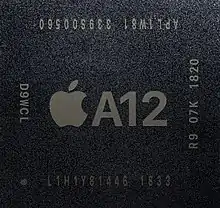 |
7 nm (N7) FinFET |
6.9 billion | 83.27 mm2 [137] |
ARMv8.3-A [138] |
Vortex | 2.49 GHz | Tempest | 1.59 GHz | P-core: L1i: 128 KB L1d: 128 KB E-core: L1i: 32 KB L1d: 32KB |
P-core: 8 MB E-core: 2 MB |
8 MB | Second generation Apple- designed (Apple G11P) |
4 | 16 | 256 | 1125 MHz | 576.0 GFLOPS | 8 | 5 TOPS | September 21, 2018 | iPhone XS & XS Max iPhone XR iPad Mini (5th Gen) iPad Air (3rd Gen) iPad (8th Gen) Apple TV 4K (2nd Gen) |
iOS 12.0 tvOS 14.5 |
iOS 17.1 (Current) iPadOS 17.1 (Current) tvOS 17.1 (Current) | |||||||||||
| 4 GB | |||||||||||||||||||||||||||||||||||||
| A12X Bionic | APL1083 | T8027 | 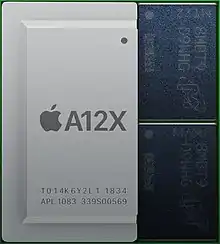 |
10 billion | 135 mm2 [139] |
4 | 8-core | Second generation Apple- designed (Apple G11G) |
7 |
28 | 448 | 1.008 TFLOPS | 128-bit | 2 channels 64-bit/channel |
68.2 GB/s | November 7, 2018 | iPad Pro 11-inch (1st Gen) & iPad Pro 12.9-inch (3rd Gen) | iOS 12.1 | |||||||||||||||||||
| 6 GB | |||||||||||||||||||||||||||||||||||||
| A12Z Bionic | 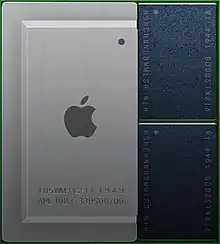 |
8 | 32 | 512 | 1.152 TFLOPS | March 25, 2020 | iPad Pro 11-inch (2nd Gen) & iPad Pro 12.9-inch (4th Gen) | iPadOS 13.4 | |||||||||||||||||||||||||||||
| 16 GB | June 22, 2020 | Developer Transition Kit (ARM, 2020) | macOS Big Sur 11.0 Beta 1 | macOS Big Sur 11.3 Beta 2 | |||||||||||||||||||||||||||||||||
| A13 Bionic |
APL1W85 | T8030 | 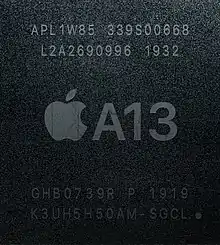 |
7 nm (N7P) FinFET |
8.5 billion | 98.48 mm2 [140] |
ARMv8.4-A [141] |
Lightning | 2 (under clocked to 2.93 GHz on iPad Mini (6th Gen) & Apple TV 4K (3rd Gen) |
2.65 GHz | Thunder | 1.72 GHz | 6-core | P-core: L1i: 192 KB L1d: 128 KB E-core: L1i: 96 KB L1d: 48 KB |
P-core: 8 MB E-core: 4 MB |
16 MB | Third generation Apple- designed [142] |
4 | 16 [143] |
256 | 1350 MHz | 691.2 GFLOPS | 5.5 TOPS | 64-bit | 4 channels 16-bit/channel |
34.1 GB/s | 3 GB | September 20, 2019 | iPhone 11 iPhone 11 Pro & 11 Pro Max iPhone SE (2nd Gen) iPad (9th Gen) Apple Studio Display |
iOS 13.0 iPadOS 13.0 |
iOS 17.1 (Current) iPadOS 17.1 (Current) tvOS 17.1 (Current) | ||||||
| 4 GB | |||||||||||||||||||||||||||||||||||||
| A14 Bionic |
APL1W01 | T8101 | 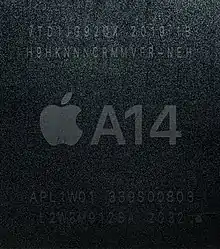 |
5 nm (N5) FinFET |
11.8 billion | 88 mm2 [144] |
ARMv8.5-A [145] |
Firestorm | 3.09 GHz | Icestorm | 1.82 GHz | P-core: L1i: 192 KB L1d: 128 KB E-core: L1i: 128 KB L1d: 64 KB |
Fourth generation Apple- designed [146][142][147] [148] |
1462.5 MHz | 748.8 GFLOPS | 16 | 11 TOPS | October 23, 2020 | iPad (10th Gen) iPad Air (4th Gen) iPhone 12 & 12 Mini iPhone 12 Pro & 12 Pro Max |
iOS 14.0 iPadOS 14.0 | |||||||||||||||||
| 4 GB | |||||||||||||||||||||||||||||||||||||
| A15 Bionic |
APL1W07 [149] |
T8110 | 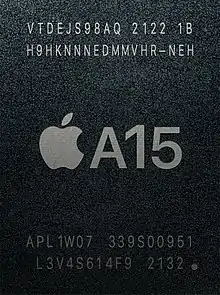 |
5 nm (N5P) FinFET |
15 billion | 108.01 mm2 [149] |
Avalanche | 3.24 GHz | Blizzard | 2.02 GHz | P-core: 12 MB E-core: 4 MB |
32 MB | Fifth generation Apple- designed [150][151][152] |
512 [143] |
1338 MHz [143][153] |
1.370 TFLOPS | 15.8 TOPS | 4 GB | September 24, 2021 | iPhone SE (3rd Gen) iPhone 13 & 13 Mini iPhone 13 Pro & 13 Pro Max iPhone 14 & 14 Plus iPad mini (6th Gen) Apple TV 4K (3rd Gen)[154] |
iOS 15.0 iPadOS 15.0 tvOS 16.1 | ||||||||||||||||
| 2.93 GHz | 5 | 20 [153][155] |
640 [153][155] |
1.712 TFLOPS | |||||||||||||||||||||||||||||||||
| 3.24 GHz | 6 GB | ||||||||||||||||||||||||||||||||||||
| A16 Bionic |
APL1W10 | T8120 |  |
4 nm (N4P) FinFET |
16 billion | 112.75 mm2 [158] |
ARMv8.6-A [159] |
Everest [160][161] |
3.46 GHz | Sawtooth [160][161] |
P-core: 16 MB E-core: 4 MB |
24 MB | Sixth generation Apple- designed |
1398 MHz [155] |
1.789 TFLOPS [155] |
17 TOPS | LPDDR5-6400 (3200 MHz) | 51.2 GB/s | September 16, 2022 | iPhone 14 Pro & 14 Pro Max iPhone 15 & 15 Plus |
iOS 16.0 | ||||||||||||||||
| A17 Pro |
APL1V02 | T8130 | 3 nm (N3B) FinFET | 19 billion | 103.80 mm2 [158] |
— | 3.78 GHz [163] |
— | 2.11 GHz [163] |
Seventh generation Apple- designed |
6 | 24 | 768 | 2.147 TFLOPS | 35 TOPS | 8 GB | September 22, 2023 | IPhone 15 Pro & 15 Pro Max | iOS 17.0 | ||||||||||||||||||
| Name | Codename | Part No. | Image | Node | Manufacturer | Transistors count | Die size | CPU ISA | Bit width | Core name | Cores | Core speed | Core name | Cores | Core speed | Overall cores | L1 | L2 | L3 | SLC | Vendor | Cores | EU count | ALU count | Frequency | FLOPS | Cores | OPS | Memory bus width | Total channel Bit per channel |
Memory type | Theoretical bandwidth |
Available capacity | First released date | Devices | Initial | Terminal |
| Performance core | Efficiency core | Cache | |||||||||||||||||||||||||||||||||||
| General | Semiconductor technology | Computer architecture | CPU | GPU | AI accelerator | Memory technology | Supported OS | ||||||||||||||||||||||||||||||
H series
The Apple "H" series is a family of SoCs with low-power audio processing and wireless connectivity for use in headphones.
Apple H1
The Apple H1 chip was used in AirPods 2nd and 3rd generation. It was also used in the Powerbeats Pro, the Beats Solo Pro, Beats Fit Pro, the AirPods Pro, the 2020 Powerbeats, AirPods Max.[164] Specifically designed for headphones, it has Bluetooth 5.0, supports hands-free "Hey Siri" commands,[165] and offers 30 percent lower latency than the W1 chip used in earlier AirPods.[166]
Apple H2
The Apple H2 chip was first used in the 2022 version of AirPods Pro. It has Bluetooth 5.3, and implements 48 kHz noise reduction in hardware.
M series
The Apple "M" series is a family of systems on a chip (SoC) used in Mac computers from November 2020 or later, iPad Pro tablets from April 2021 or later, iPad Air tablets from March 2022 or later, and Vision Pro. The "M" designation was previously used for Apple motion coprocessors.
| Evolution of Apple "M" series | ||||||||||||||||||||||||||||||||||||||||||||||||||||||||||||||||||||||||||||||||||||||||||||||||||||||||||||||||||||||||||||||||||||||||||||||||||||||||||||||||||||||||||||||||||||||||||||||||||||||
|---|---|---|---|---|---|---|---|---|---|---|---|---|---|---|---|---|---|---|---|---|---|---|---|---|---|---|---|---|---|---|---|---|---|---|---|---|---|---|---|---|---|---|---|---|---|---|---|---|---|---|---|---|---|---|---|---|---|---|---|---|---|---|---|---|---|---|---|---|---|---|---|---|---|---|---|---|---|---|---|---|---|---|---|---|---|---|---|---|---|---|---|---|---|---|---|---|---|---|---|---|---|---|---|---|---|---|---|---|---|---|---|---|---|---|---|---|---|---|---|---|---|---|---|---|---|---|---|---|---|---|---|---|---|---|---|---|---|---|---|---|---|---|---|---|---|---|---|---|---|---|---|---|---|---|---|---|---|---|---|---|---|---|---|---|---|---|---|---|---|---|---|---|---|---|---|---|---|---|---|---|---|---|---|---|---|---|---|---|---|---|---|---|---|---|---|---|---|---|
| ||||||||||||||||||||||||||||||||||||||||||||||||||||||||||||||||||||||||||||||||||||||||||||||||||||||||||||||||||||||||||||||||||||||||||||||||||||||||||||||||||||||||||||||||||||||||||||||||||||||
Apple M1
The M1, Apple's first system on a chip designed for use in Macs, is manufactured using TSMC's 5 nm process. Announced on November 10, 2020, it is used in the MacBook Air (M1, 2020), Mac mini (M1, 2020), MacBook Pro (13-inch, M1, 2020), iMac (24-inch, M1, 2021), iPad Pro (5th generation) and iPad Air (5th generation). It comes with 4 performance cores and 4 efficiency cores, for a total of 8 CPU cores. It comes with up to 8 GPU cores, with the entry level MacBook Air having only 7 GPU cores. The M1 has 16 billion transistors.[171]
Apple M1 Pro
The M1 Pro is a more powerful version of the M1, with six to eight performance cores, two efficiency cores, 14 to 16 GPU cores, 16 Neural Engine cores, up to 32 GB unified RAM with up to 200 GB/s memory bandwidth, and more than double the transistors. It was announced on October 18, 2021, and is used in the 14- and 16-inch MacBook Pro. Apple claimed the CPU performance is about 70% faster than the M1, and that its GPU performance is about double. Apple claims the M1 Pro can deliver up to 20 streams of 4K or 7 streams of 8K ProRes video playback (up from 6 offered by Afterburner card for 2019 Mac Pro).
Apple M1 Max
The M1 Max is a larger version of the M1 Pro chip, with eight performance cores, two efficiency cores, 24 to 32 GPU cores, 16 Neural Engine cores, up to 64 GB unified RAM with up to 400 GB/s memory bandwidth, and more than double the number of transistors. It was announced on October 18, 2021, and is used in the 14- and 16-inch MacBook Pro, as well as the Mac Studio. Apple claims it has 57 billion transistors.[172] Apple claims the M1 Max can deliver up to 30 streams of 4K (up from 23 offered by Afterburner card for 2019 Mac Pro) or 7 streams of 8K ProRes video playback.
Apple M1 Ultra
The M1 Ultra consists of two M1 Max dies connected together by a silicon interposer through Apple's UltraFusion technology.[173] It has 114 billion transistors, 16 performance cores, 4 efficiency cores, 48 to 64 GPU cores and 32 Neural Engine cores; it can be configured with up to 128 GB unified RAM of 800 GB/s memory bandwidth. It was announced on March 8, 2022, as an optional upgrade for the Mac Studio. Apple claims the M1 Ultra can deliver up to 18 streams of 8K ProRes video playback.[174]
Apple M2
Apple announced the M2 SoC on June 6, 2022, at WWDC, along with the new MacBook Air and the new 13-inch MacBook Pro and later the iPad Pro (6th generation). It is the successor to the Apple M1. The M2 is made with TSMC's "Enhanced 5-nanometer technology" N5P process and contains 20 billion transistors, a 25% increase from the previous generation M1. The M2 can be configured with up to 24 gigabytes of RAM and 2 terabytes of storage. It has 8 CPU cores (4 performance and 4 efficiency) and up to 10 GPU cores. The M2 also increases the memory bandwidth to 100 GB/s. Apple claims CPU improvements up to 18% and GPU improvements up to 35% compared to the previous M1.[175]
Apple M2 Pro
The M2 Pro is a more powerful version of the M2, with six to eight performance cores, four efficiency cores, 16 to 19 core GPU, 16 Apple Next Generation Neural Engine cores, up to 32 GBs of unified RAM with up to 200 GB/s memory bandwidth, and over 40 billion transistors, 20 percent more than the M1 Pro and twice the M2. It was announced on January 17, 2023 in a press release and it is used in the 14- and 16-inch 2023 MacBook Pro (Apple silicon) as well as the Mac Mini. Apple claims the CPU performance on the M2 Pro is 20 percent faster than the M1 Pro and the GPU is 30 percent faster than the one on the M1 Pro.[176]
Apple M2 Max
The M2 Max is a larger more powerful version of the M2 Pro, with eight performance cores, four efficiency cores, 30 to 38 core GPU, 16 Apple Next Generation Neural Engine cores, up to 96 GBs of unified RAM with up to 400 GB/s memory bandwidth, and over 67 billion transistors, 10 billion more than the M1 Max and 3x the M2. It was announced on January 17, 2023 in a press release and it is used in the 14- and 16-inch 2023 MacBook Pro (Apple silicon). On June 5, 2023 at WWDC Apple unveiled a refreshed Mac Studio powered by the M2 Max.[177] Apple claims the CPU performance on the M2 Max is 20 percent faster that M1 Max and the GPU is 30 percent faster than the M1 Max. According to Apple, "the M2 Max is the most powerful and efficient chip in a pro laptop".[176]
Apple M2 Ultra
The M2 Ultra consists of two M2 Max dies connected together by a silicon interposer through Apple's UltraFusion technology. It has 134 billion transistors, 16 performance cores, 8 efficiency cores, 60 to 76 GPU cores and 32 Neural Engine cores; it can be configured with up to 192 GB unified RAM of 800 GB/s memory bandwidth. It was announced on June 5, 2023, as an optional upgrade for the Mac Studio and the sole processor for the Apple silicon Mac Pro. Apple claims the M2 Ultra can deliver up to 22 streams of 8K ProRes video playback.[178]
List of processors
| General | Semiconductor technology | CPU | GPU | AI accelerator | Memory technology | Connectivity | First released date | Devices | Supported OS | ||||||||||||||||||||||||||
|---|---|---|---|---|---|---|---|---|---|---|---|---|---|---|---|---|---|---|---|---|---|---|---|---|---|---|---|---|---|---|---|---|---|---|---|
| Name | Codename and part no. |
Image | Process | Transistor count and die size |
CPU ISA | Codename | Cores | Clocks (GHz) | Cache | Vendor | Cores | SIMD EU count | FP32 ALU count | Frequency | FP32 FLOPS | Cores | OPS | Memory bus width | Total channel Bit per channel |
Memory type | Theoretical bandwidth |
Available capacity | Ports | External display | Initial | Terminal | |||||||||
| P | E | P | E | P | E | L1 | L2 | SLC | Thunderbolt | USB | Max | ||||||||||||||||||||||||
| M1 | APL1102 T8103 |
 |
TSMC N5 | 16 billion 118.91 mm² [179] |
ARMv8.5-A | Firestorm | Icestorm | 4 | 4 | 3.204 | 2.064 | P-core: L1i: 192 KB L1d: 128 KB E-core: L1i: 128 KB L1d: 64 KB |
P-core: 12 MB E-core: 4 MB |
8 MB | Fourth generation Apple-designed | 7 | 28 | 896 | 1278 MHz | 2.290 TFLOPS | 16 | 11 TOPS | 128-bit | 2 channels 64-bit/channel |
LPDDR4X-4266 (2133 MHz) |
66.67 GB/s | 8 GB 16 GB[lower-alpha 9] |
Thunderbolt 3 (Up to 40 Gbit/s)[lower-alpha 10] |
USB4 (Up to 40 Gbit/s)[lower-alpha 11] USB 3.1 Gen 2 (Up to 10 Gbit/s) |
iPad Air/Pro: 1x TB 3 with DP 1.4/USB 3.1 Gen 2/USB4 compatibility[lower-alpha 12] MacBook Air/Pro: 2x TB 3 with DP 1.4/USB 3.1 Gen 2/USB4 compatibility & 1x 3.5 mm headphone jack iMac (4 ports): 2x TB 3 with DP 1.4/USB 3.1 Gen 2/USB4 compatibility, 2x USB-C 3.1 Gen 2, 1x 3.5 mm headphone jack & 1x 1 Gb Ethernet Mac mini: 2x TB 3 with DP 1.4/USB 3.1 Gen 2/USB4 compatibility, 2x USB-A 3.0, 1x HDMI 2.0, 1x 3.5 mm headphone jack & 1x 1 or 10 Gb Ethernet |
All: One 6016 x 3384 at 60 Hz at 8-bit color depth display over Thunderbolt/USB-C Mac mini: One 6016 x 3384 at 60 Hz at 8-bit color depth display over Thunderbolt and one 3840 x 2160 at 60 Hz at 8-bit color depth display over HDMI |
November 17, 2020 |
|
macOS Big Sur 11.0 iPadOS 14.5 |
macOS 14 Sonoma (Current) iPadOS 17.1 (Current) |
| 8 | 32 | 1024 | 2.617 TFLOPS | ||||||||||||||||||||||||||||||||
| M1 Pro | APL1103 T6000 |
 |
33.7 billion ≈ 245 mm² [185] |
6 | 2 | 3.228 | P-core: 24 MB E-core: 4 MB |
24 MB | 14 | 56 | 1792 | 1296 MHz | 4.644 TFLOPS | 256-bit | 2 channels 128-bit/channel |
LPDDR5-6400 (3200 MHz) |
204.8 GB/s | 16 GB 32 GB[lower-alpha 13] |
Thunderbolt 4 (Up to 40 Gbit/s) |
MacBook Pro: 3x TB 4 with DP 1.4/USB 3.1 Gen 2/USB4 compatibility, 1x SDXC card slot (UHS-II), 1x HDMI 2.0, 1x 3.5 mm headphone jack & 1x MagSafe 3 |
Two 6016 x 3384 at 60 Hz at 10-bit color depth displays over Thunderbolt or One 6016 x 3384 at 60 Hz at 10-bit color depth display over Thunderbolt and one 3840 x 2160 at 60 Hz at 10-bit color depth display over HDMI |
October 26, 2021 | macOS Monterey 12.0 | macOS 14 Sonoma (Current) | |||||||||||
| 8 | |||||||||||||||||||||||||||||||||||
| 16 | 64 | 2048 | 5.308 TFLOPS | ||||||||||||||||||||||||||||||||
| M1 Max | APL1105 T6001 [186] |
 |
57 billion ≈ 432 mm² [185] |
48 MB | 24 | 96 | 3072 | 7.962 TFLOPS | 512-bit | 4 channels 128-bit/channel |
409.6 GB/s | 32 GB 64 GB[lower-alpha 14] |
MacBook Pro: 3x TB 4 with DP 1.4/USB 3.1 Gen 2/USB4 compatibility, 1x SDXC card slot (UHS-II), 1x HDMI 2.0, 1x 3.5 mm headphone jack & 1x MagSafe 3 Mac Studio: 4x TB 4 with DP 1.4/USB 3.1 Gen 2/USB4 compatibility, 2x USB-C 3.1 Gen 2, 2x USB-A 3.0, 1x SDXC card slot (UHS-II), 1x HDMI 2.0, 1x 3.5 mm headphone jack & 1x 10 Gb Ethernet |
MacBook: Three 6016 x 3384 at 60 Hz at 10-bit color depth displays over Thunderbolt and one 3840 x 2160 at 60 Hz at 10-bit color depth display over HDMI Mac Studio: Four 6016 x 3384 at 60 Hz at 10-bit color depth displays over Thunderbolt and one 3840 x 2160 at 60 Hz at 10-bit color depth display over HDMI |
| ||||||||||||||||||||
| 32 | 128 | 4096 | 10.616 TFLOPS | ||||||||||||||||||||||||||||||||
| M1 Ultra | APL1W06 T6002 |
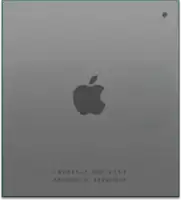 |
114 billion ≈ 864 mm² |
16 | 4 | P-core: 48 MB E-core: 8 MB |
96 MB | 48 | 192 | 6144 | 15.925 TFLOPS | 32 | 22 TOPS | 1024-bit | 8 channels 128-bit/channel |
819.2 GB/s | 64 GB 128 GB[lower-alpha 15] |
Mac Studio: 6x TB 4 with DP 1.4/USB 3.1 Gen 2/USB4 compatibility, 2x USB-A 3.0, 1x SDXC card slot (UHS-II), 1x HDMI 2.0, 1x 3.5 mm headphone jack & 1x 10 Gb Ethernet |
Four 6016 x 3384 at 60 Hz at 10-bit color depth displays over Thunderbolt and one 3840 x 2160 at 60 Hz at 10-bit color depth display over HDMI |
March 18, 2022 | macOS Monterey 12.3 | ||||||||||||||
| 64 | 256 | 8192 | 21.233 TFLOPS | ||||||||||||||||||||||||||||||||
| M2 | APL1109 T8112 |
 |
TSMC N5P | 20 billion 155.25 mm² [179] |
Avalanche | Blizzard | 4 | 4 | 3.504 | 2.424 | P-core: 16 MB E-core: 4 MB |
8 MB | Fifth generation Apple-designed | 8 | 32 | 1024 | 1398 MHz | 2.863 TFLOPS | 16 | 15.8 TOPS | 128-bit | 2 channels 64-bit/channel |
102.4 GB/s | 8 GB 16 GB[lower-alpha 16] 24 GB[lower-alpha 17] |
Thunderbolt 3 (Up to 40 Gbit/s)[lower-alpha 18] Thunderbolt 4 (Up to 40 Gbit/s)[lower-alpha 19] |
iPad Pro: 1x TB 3 with DP 1.4/USB4/ USB 3.1 Gen 2 compatibility MacBook Air/Pro: 2x TB 3 with DP 1.4/USB4/ USB 3.1 Gen 2 compatibility & 1x 3.5 mm headphone jack Mac mini: 2x TB 4 with DP 1.4/USB4/ USB 3.1 Gen 2 compatibility, 2x USB-A 3.0, 1x HDMI 2.0, 1x 3.5 mm headphone jack & 1x 1 or 10 Gb Ethernet |
All: One 6016 x 3384 at 60 Hz at 8-bit color depth display over Thunderbolt Mac mini: One 6016 x 3384 at 60 Hz at 8-bit color depth display over Thunderbolt and one 5120 x 2880 at 60 Hz at 8-bit color depth display over Thunderbolt or One 6016 x 3384 at 60 Hz at 8-bit color depth display over Thunderbolt and one 3840 x 2160 at 60 Hz at 8-bit color depth display over HDMI |
June 24, 2022 |
|
macOS Monterey 12.4 iPadOS 16.1 |
macOS 14 Sonoma (Current) iPadOS 17.1 | ||||
| 10 | 40 | 1280 | 3.578 TFLOPS | ||||||||||||||||||||||||||||||||
| M2 Pro | APL1113 T6020 |
40 billion | 6 | P-core: 32 MB E-core: 4 MB |
24 MB | 16 | 64 | 2048 | 5.726 TFLOPS | 256-bit | 4 channels 64-bit/channel |
204.8 GB/s | 16 GB 32 GB[lower-alpha 20] |
Thunderbolt 4 (Up to 40 Gbit/s) |
MacBook Pro: 3x TB 4 with DP 1.4/ USB 3.1 Gen 2/USB4 compatibility, 1x SDXC card slot (UHS-II), 1x HDMI 2.1 & 1x MagSafe 3 Mac mini: 4x TB 4 with DP 1.4/USB4/ USB 3.1 Gen 2 compatibility, 2x USB-A 3.0, 1x HDMI 2.1, 1x 3.5 mm headphone jack & 1x 1 or 10 Gb Ethernet |
All: One 6016 x 3384 at 60 Hz at 10-bit color depth display over Thunderbolt and one 3840 x 2160 at 144 Hz at 8-bit color depth display over HDMI or One 3840 x 2160 at 240 Hz at 8-bit color depth display over HDMI or One 7680 x 4320 at 60 Hz at 8-bit color depth display over HDMI or MacBook: Two 6016 x 3384 at 60 Hz at 10-bit color depth displays over Thunderbolt Mac mini: Two 6016 x 3384 at 60 Hz at 10-bit color depth displays over Thunderbolt and one 3840 x 2160 at 60 Hz at 8-bit color depth display over HDMI |
January 24, 2023 | macOS Ventura 13.2 | macOS Ventura 13.4 (Current) | ||||||||||||||||
| 8 | 19 | 76 | 2432 | 6.799 TFLOPS | |||||||||||||||||||||||||||||||
| M2 Max | APL1111 T6021 |
67 billion | 3.667 | 48 MB | 30 | 120 | 3840 | 10.736 TFLOPS | 512-bit | 4 channels 128-bit/channel |
409.6 GB/s | 32 GB 64 GB[lower-alpha 21] 96 GB[lower-alpha 22] |
MacBook Pro: 3x TB 4 with DP 1.4/ USB 3.1 Gen 2/USB4 compatibility, 1x SDXC card slot (UHS-II), 1x HDMI 2.1 & 1x MagSafe 3 Mac Studio: 4x TB 4 with DP 1.4/USB 3.1 Gen 2/USB4 compatibility, 2x USB-C 3.1 Gen 2, 2x USB-A 3.0, 1x SDXC card slot (UHS-II), 1x HDMI 2.1, 1x 3.5 mm headphone jack & 1x 10 Gb Ethernet |
All: Two 6016 x 3384 at 60 Hz at 10-bit color depth displays over Thunderbolt and one 7680 x 4320 at 60 Hz at 8-bit color depth display over HDMI or Two 6016 x 3384 at 60 Hz at 10-bit color depth displays over Thunderbolt and one 3840 x 2160 at 240 Hz at 8-bit color depth display over HDMI or MacBook Pro: Three 6016 x 3384 at 60 Hz at 10-bit color depth displays over Thunderbolt and one 3840 x 2160 at 144 Hz at 8-bit color depth display over HDMI or Mac Studio: Four 6016 x 3384 at 60 Hz at 10-bit color depth displays over Thunderbolt and one 3840 x 2160 at 60 Hz at 8-bit color depth display over HDMI |
|||||||||||||||||||||
| 38 | 152 | 4864 | 13.599 TFLOPS | ||||||||||||||||||||||||||||||||
| M2 Ultra | APL1W12 | 134 billion | 16 | 8 | ~ 3.000 -3.667 [189] |
P-core: 64 MB E-core: 8 MB |
96 MB | 60 | 240 | 7680 | 21.473 TFLOPS | 32 | 31.6 TOPS | 1024-bit | 8 channels 128-bit/channel |
819.2 GB/s | 64 GB 128 GB[lower-alpha 23] 192 GB[lower-alpha 24] |
Mac Studio: 6x TB 4 with DP 1.4/USB 3.1 Gen 2/USB4 compatibility, 2x USB-A 3.0, 1x SDXC card slot (UHS-II), 1x HDMI 2.1, 1x 3.5 mm headphone jack & 1x 10 Gb Ethernet Mac Pro: 8x TB 4 with DP 1.4/USB 3.1 Gen 2/USB4 compatibility, 3x USB-A 3.0, 2x HDMI 2.1, 2x SATA 3.5, 1x 3.5 mm headphone jack, 2x 10 Gb Ethernet & 7x PCI Express expansion slots (1x 1/2 length Gen 3 x4, 6x full length Gen 4 (4x8 & 2x16)) |
Eight 3840 x 2160 at 60 Hz at 10-bit color depth displays or Six 6016 x 3384 at 60 Hz at 10-bit color depth displays or Three 7680 x 4320 at 60 Hz at 8-bit color depth displays over HDMI |
June 13th, 2023 |
|
macOS Ventura 13.4 | Upcoming | ||||||||||||
| 76 | 304 | 9728 | 27.199 TFLOPS | ||||||||||||||||||||||||||||||||
| Name | Codename and part no. |
Image | Process | Transistor count and die size |
CPU ISA | P | E | P | E | P | E | L1 | L2 | SLC | Vendor | Cores | EU count | ALU count | Frequency | FLOPS | Cores | OPS | Memory bus width | Total channel Bit per channel |
Memory type | Theoretical bandwidth |
Available capacity | Thunderbolt | USB | Max | External display | First released date | Devices | Initial | Terminal |
| Codename | Cores | Clocks (GHz) | Cache | Ports | |||||||||||||||||||||||||||||||
| General | Semiconductor technology | CPU | GPU | AI accelerator | Memory technology | Connectivity | Supported OS | ||||||||||||||||||||||||||||
R series
Apple R1
The Apple R1 was announced by Apple on June 5, 2023 at its Worldwide Developers Conference. It will be used in the Apple Vision Pro headset. The Apple R1 is dedicated to the real time processing of sensor inputs and delivering extremely low-latency images to the displays.
S series
| Evolution of Apple "S" series | |||||||||||||||||||||||||||||||||||||||||||||||||||||||||||||||||||||||||||||||||||||||||||||||||||||||||||||||||||||||||||||||||||||||||||||||||||||||||||||||||||||||||||||||||||||||||||||||||
|---|---|---|---|---|---|---|---|---|---|---|---|---|---|---|---|---|---|---|---|---|---|---|---|---|---|---|---|---|---|---|---|---|---|---|---|---|---|---|---|---|---|---|---|---|---|---|---|---|---|---|---|---|---|---|---|---|---|---|---|---|---|---|---|---|---|---|---|---|---|---|---|---|---|---|---|---|---|---|---|---|---|---|---|---|---|---|---|---|---|---|---|---|---|---|---|---|---|---|---|---|---|---|---|---|---|---|---|---|---|---|---|---|---|---|---|---|---|---|---|---|---|---|---|---|---|---|---|---|---|---|---|---|---|---|---|---|---|---|---|---|---|---|---|---|---|---|---|---|---|---|---|---|---|---|---|---|---|---|---|---|---|---|---|---|---|---|---|---|---|---|---|---|---|---|---|---|---|---|---|---|---|---|---|---|---|---|---|---|---|---|---|---|---|
| |||||||||||||||||||||||||||||||||||||||||||||||||||||||||||||||||||||||||||||||||||||||||||||||||||||||||||||||||||||||||||||||||||||||||||||||||||||||||||||||||||||||||||||||||||||||||||||||||
The Apple "S" series is a family of systems in a package (SiP) used in the Apple Watch and HomePod. It uses a customized application processor that together with memory, storage and support processors for wireless connectivity, sensors, and I/O form a complete computer in a single package. They are designed by Apple and manufactured by contract manufacturers such as Samsung.
Apple S1
The Apple S1 is an integrated computer. It includes memory, storage and support circuits like wireless modems and I/O controllers in a sealed integrated package. It was announced on September 9, 2014, as part of the "Wish we could say more" event. It was used in the first-generation Apple Watch.[190]
Apple S1P
Used in Apple Watch Series 1. It has a dual-core processor identical to the S2, with the exception of the built-in GPS receiver. It contains the same dual-core CPU with the same new GPU capabilities as the S2, making it about 50% faster than the S1.[191][192]
Apple S2
Used in the Apple Watch Series 2. It has a dual-core processor and a built-in GPS receiver. The S2's two cores deliver 50% higher performance and the GPU delivers twice as much as the predecessor,[193] and is similar in performance to the Apple S1P.[194]
Apple S3
Used in the Apple Watch Series 3. It has a dual-core processor that is 70% faster than the Apple S2 and a built-in GPS receiver.[195] There is also an option for a cellular modem and an internal eSIM module.[195] It also includes the W2 chip.[195] The S3 also contains a barometric altimeter, the W2 wireless connectivity processor, and in some models UMTS (3G) and LTE (4G) cellular modems served by a built-in eSIM.[195]
Apple S4
Used in the Apple Watch Series 4. It has a custom 64-bit dual-core processor based on the A12 with up to 2× faster performance. It also contains the W3 wireless chip, which supports Bluetooth 5. The S4 introduced 64-bit ARMv8 cores to the Apple Watch. The chip contains two Tempest cores,[196][197] which are the energy-efficient cores found in the A12. Despite the small size, Tempest still uses a 3-wide decode out-of-order superscalar design, which make them much more powerful than previous in-order cores.
The S4 contains a Neural Engine that is able to run Core ML.[198] Third-party apps can use it starting from watchOS 6. The SiP also includes new accelerometer and gyroscope functionality that has twice the dynamic range in measurable values of its predecessor, as well as being able to sample data at 8 times the speed.[199] It also contains a new custom GPU, which can use the Metal API.[200]
Apple S5
Used in the Apple Watch Series 5, Watch SE, and HomePod mini.[201] It adds a built-in magnetometer to the custom 64-bit dual-core processor and GPU of the S4.[202]
Apple S6
Used in the Apple Watch Series 6. It has a custom 64-bit dual-core processor that runs up to 20 percent faster than the S5.[203][204] The dual cores in the S6 are based on the A13's energy-efficient "little" Thunder cores at 1.8 GHz.[205] Like the S4 and S5, it also contains the W3 wireless chip.[204] The S6 adds the new U1 ultra wideband chip, an always-on altimeter, and 5 GHz WiFi.[203][204]
Apple S7
Used in the Apple Watch Series 7 and second-generation HomePod. The S7 has the same T8301 identifier and quoted performance as the S6.[206]
Apple S8
Used in the Apple Watch SE (2nd generation), Watch Series 8, and Watch Ultra. The S8 adds a new three-axis gyroscope and high g-force accelerometer.[207] It has the same T8301 identifier and quoted performance as the S6 and S7.[208]
Apple S9
Used in the Apple Watch Series 9 and Watch Ultra 2. The S9 has a new dual-core CPU with 60 percent more transistors than the S8, and a new four-core Neural Engine.[209]
List of processors
| Name | Model no. | Image | Semiconductor technology | Die size | CPU ISA | CPU | CPU cache | GPU | Memory technology | Modem | First Released | Utilizing devices | Initial OS | Terminal OS |
|---|---|---|---|---|---|---|---|---|---|---|---|---|---|---|
| S1 | APL 0778 [210] |
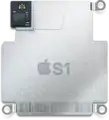 |
28 nm Hκ MG[211][212] | 32 mm2[211] | ARMv7k[212][213] | 520 MHz single-core Cortex-A7[212] | L1d: 32 KB[212] L2: 256 KB[212] |
PowerVR Series 5[212][214] | LPDDR3[215] | April 2015 | watchOS 1.0 | watchOS 4.3.2 | ||
| S1P | TBC |  |
TBC | ARMv7k[216][217][193] | 520 MHz dual-core Cortex-A7 without GPS[216] | TBC | PowerVR Series 6 'Rogue'[216] | LPDDR3 | September 2016 | watchOS 3.0 | watchOS 6.3 | |||
| S2 | 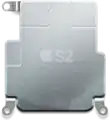 |
520 MHz dual-core Cortex-A7[216] | ||||||||||||
| S3 |  |
ARMv7k[218] | Dual-core | TBC | LPDDR4 | Qualcomm MDM9635M (Snapdragon X7 LTE) | September 2017 | watchOS 4.0 | watchOS 8.7.1 | |||||
| S4 |  |
7 nm (TSMC N7) | TBC | ARMv8-A ILP32[219][220] | 1.59 GHz Dual-core Tempest | TBC | Apple G11M[220] | TBC | September 2018 | watchOS 5.0 | watchOS 10.0 (Current)
audioOS 17.0 (Current) | |||
| S5 |  |
September 2019 | watchOS 6.0
audioOS 14.2 | |||||||||||
| S6 |  |
7 nm (TSMC N7P) | TBC | 1.8 GHz Dual-core Thunder | TBC | September 2020 | watchOS 7.0 | |||||||
| S7 |  |
October 2021 | watchOS 8.0
audioOS 16.3 | |||||||||||
| S8 |  |
September 2022 | watchOS 9.0 | |||||||||||
| S9 | TBC | TBC | September 2023 | watchOS 10.0 | ||||||||||
| Name | Model no. | Image | Semiconductor technology | Die size | CPU ISA | CPU | CPU cache | GPU | Memory technology | Modem | First Released | Utilizing devices | Initial OS | Terminal OS |
T series
The T series chip operates as a secure enclave on Intel-based MacBook and iMac computers released from 2016 onwards. The chip processes and encrypts biometric information (Touch ID) and acts as a gatekeeper to the microphone and FaceTime HD camera, protecting them from hacking. The chip runs bridgeOS, a purported variant of watchOS.[221] The functions of the T series processor were built into the M series CPUs, thus ending the need for the T series.
Apple T1
The Apple T1 chip is an ARMv7 SoC (derived from the processor in the Apple Watch's S2) that drives the System Management Controller (SMC) and Touch ID sensor of the 2016 and 2017 MacBook Pro with Touch Bar.[222]
Apple T2
The Apple T2 security chip is a SoC first released in the iMac Pro. It is a 64-bit ARMv8 chip (a variant of the A10 Fusion, or T8010).[223] It provides a secure enclave for encrypted keys, enables users to lock down the computer's boot process, handles system functions like the camera and audio control, and handles on-the-fly encryption and decryption for the solid-state drive.[224][225][226] T2 also delivers "enhanced imaging processing" for the iMac Pro's FaceTime HD camera.[227][228]
List of processors
| Name | Model no. | Image | Semiconductor technology | Die size | CPU ISA | CPU | CPU cache | GPU | Memory technology | First Released |
|---|---|---|---|---|---|---|---|---|---|---|
| Memory bandwidth | ||||||||||
| T1 | APL 1023 [229] |
 |
Same as S2 | TBC | ARMv7 | TBD | November 12, 2016 | |||
| T2 | APL 1027 [230] |
 |
TSMC 16 nm FinFET.[231] | 104 mm2[231] | ARMv8-A ARMv7-A |
2× Hurricane 2× Zephyr + Cortex-A7 |
L1i: 64 KB L1d: 64 KB L2: 3 MB[231] |
3× cores[231] | LP-DDR4[231] | December 14, 2017 |
| Name | Model no. | Image | Semiconductor technology | Die size | CPU ISA | CPU | CPU cache | GPU | Memory bandwidth | First Released |
| Memory technology |
U series
The Apple "U" series is a family of systems in a package (SiP) implementing ultra-wideband (UWB) radio.
Apple U1
The Apple U1 is used in the iPhone 11 series up until the iPhone 15 series. (excluding the second and third generation iPhone SE), Apple Watch Series 6 (and Apple Watch Ultra) up until the Apple Watch Series 9 (and Apple Watch Ultra 2), HomePod (2nd generation), HomePod Mini, AirTag trackers and the charging case for AirPods Pro (2nd generation).[232]
List of processors
| Name | Model no. | Image | CPU | Semiconductor technology | First Released |
|---|---|---|---|---|---|
| U1 | TMK
A75 |
 |
Cortex-M4 ARMv7E-M[234] |
16 nm FinFET (TSMC 16FF) |
September 20, 2019 |
| Name | Model no. | Image | CPU | Semiconductor technology | First Released |
W series
The Apple "W" series is a family of RF SoCs used for Bluetooth and Wi-Fi connectivity.
Apple W1
The Apple W1 is a SoC used in the 2016 AirPods and select Beats headphones.[235][236] It maintains a Bluetooth[237] Class 1 connection with a computer device and decodes the audio stream that is sent to it.[238]
Apple W2
The Apple W2, used in the Apple Watch Series 3, is integrated into the Apple S3 SiP. Apple claimed the chip makes Wi-Fi 85% faster and allows Bluetooth and Wi-Fi to use half the power of the W1 implementation.[195]
Apple W3
The Apple W3 is used in the Apple Watch Series 4,[239] Series 5,[240] Series 6,[204] SE (1st generation),[204] Series 7, Series 8, SE (2nd generation), and Ultra. It is integrated into the Apple S4, S5, S6, S7 and S8 SiPs. It supports Bluetooth 5.0/5.3.
List of processors
| Name | Model no. | Image | Semiconductor technology | Die size | CPU ISA | CPU | CPU cache | Memory technology | Bluetooth | First Released |
|---|---|---|---|---|---|---|---|---|---|---|
| Memory bandwidth | ||||||||||
| W1 | 343S00130[241] 343S00131[241] |
 |
TBC | 14.3 mm2 [241] |
TBC | 4.2 | December 13, 2016 | |||
| W2 | 338S00348[242] |  |
TBC | September 22, 2017 | ||||||
| W3 | 338S00464[243] |  |
5.0/5.3 | September 21, 2018 | ||||||
| Name | Model no. | Image | Semiconductor technology | Die size | CPU ISA | CPU | CPU cache | Memory bandwidth | Bluetooth | First Released |
| Memory technology | ||||||||||
M-series coprocessors
The Apple M-series coprocessors are motion coprocessors used by Apple Inc. in their mobile devices. First released in 2013, their function is to collect sensor data from integrated accelerometers, gyroscopes and compasses and offload the collecting and processing of sensor data from the main central processing unit (CPU).
Only the M7 and M8 coprocessors were housed on separate chips; the M9, M10, and M11 coprocessors were embedded in their corresponding A-series chips. Beginning with the A12 Bionic chip in 2018, the motion coprocessors were fully integrated into the SoC; this allowed Apple to reuse the "M"-series codename for their desktop SoCs.
List of coprocessors
| Name | Model no. | Image | Semiconductor technology | CPU ISA | CPU | First Released | Utilizing devices |
|---|---|---|---|---|---|---|---|
| Apple M7 | LPC18A1 |  |
90 nm | ARMv7-M | 150 MHz Cortex-M3 | September 10, 2013 |
|
| Apple M8 | LPC18B1 | 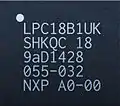 |
September 9, 2014 |
||||
| Name | Model no. | Image | Semiconductor technology | CPU ISA | CPU | First Released | Utilizing devices |
Miscellaneous devices
This segment is about Apple-designed processors that are not easily sorted into another section.
Early series
Apple first used SoCs in early versions of the iPhone and iPod Touch. They combine in one package a single ARM-based processing core (CPU), a graphics processing unit (GPU), and other electronics necessary for mobile computing.
The APL0098 (also 8900B[244] or S5L8900) is a package on package (PoP) system on a chip (SoC) that was introduced on June 29, 2007, at the launch of the original iPhone. It includes a 412 MHz single-core ARM11 CPU and a PowerVR MBX Lite GPU. It was manufactured by Samsung on a 90 nm process.[11] The iPhone 3G and the first-generation iPod Touch also use it.[245]
The APL0278[246] (also S5L8720) is a PoP SoC introduced on September 9, 2008, at the launch of the second-generation iPod Touch. It includes a 533 MHz single-core ARM11 CPU and a PowerVR MBX Lite GPU. It was manufactured by Samsung on a 65 nm process.[11][245]
The APL0298 (also S5L8920) is a PoP SoC introduced on June 8, 2009, at the launch of the iPhone 3GS. It includes a 600 MHz single-core Cortex-A8 CPU and a PowerVR SGX535 GPU. It was manufactured by Samsung on a 65 nm process.[107]
The APL2298 (also S5L8922) is a 45 nm die shrunk version of the iPhone 3GS SoC[11] and was introduced on September 9, 2009, at the launch of the third-generation iPod Touch.
Other
The Samsung S5L8747 is an ARM-based microcontroller used in Apple's Lightning Digital AV Adapter, a Lightning-to-HDMI adapter. This is a miniature computer with 256 MB RAM, running an XNU kernel loaded from the connected iPhone, iPod Touch, or iPad, then taking a serial signal from the iOS device translating that into a proper HDMI signal.[247][248]
| Model no. | Image | First released | CPU ISA | Specs | Application | Utilizing devices | Operating system |
|---|---|---|---|---|---|---|---|
| 339S0196 |  |
September 2012 | Unknown | 256 MB RAM |
Lightning to HDMI conversion |
Apple Digital AV Adapter |
XNU |
| Model no. | Image | First released | CPU ISA | Specs | Application | Utilizing devices | Operating system |
See also
- ARM Cortex-A9
- List of iPhone models
- List of iPad models
- List of Mac models grouped by CPU type
- List of Samsung platforms (SoCs):
- Exynos (none have been used by Apple)
- historical (some were used in Apple products)
- PowerVR SGX GPUs were also used in the iPhone 3GS and the third-generation iPod Touch
- PWRficient, a processor designed by P.A. Semi, a company Apple acquired to form an in-house custom chip design department
Similar platforms
- A31 by AllWinner
- Atom by Intel
- BCM2xxxx by Broadcom
- eMAG and Altra by Ampere Computing
- Exynos by Samsung
- i.MX by Freescale Semiconductor
- Jaguar and Puma by AMD
- Kirin by HiSilicon
- MTxxxx by MediaTek
- NovaThor by ST-Ericsson
- OMAP by Texas Instruments
- RK3xxx by Rockchip
- Snapdragon by Qualcomm
- Tegra by Nvidia
Notes
- Could be referred to as "A1" though it is not labelled as such
- Could be referred to as "A2" though it is not labelled as such
- Sometimes referred to as "A3" though it is not labelled as such
- iPad (1st generation)
- iPod touch (5th generation), iPad 2 (Wi-Fi), iPad (3rd generation, Wi-Fi), iPad mini (1st generation, Wi-Fi)
- iPhone 4S, iPad 2 (Wi-Fi + Cellular), iPad (3rd generation, Wi-Fi + Cellular), iPad mini (1st generation, Wi-Fi + Cellular)
- iPhone 5C and iPad (4th generation, Wi-Fi)
- iPhone 5 and iPad (4th generation, Wi-Fi + Cellular)
- iPad Pro 12.9-inch (5th generation) with 1 TB and 2 TB storage, iPad Pro 11-inch (3rd generation) with 1 TB and 2 TB storage, online configured MacBook Air (M1) and online configured MacBook Pro 13-inch (M1)
- Except iPad Air (5th generation)
- Except iPad Air (5th generation)
- Except iPad Air (5th generation) which only contains 1x USB-C 3.1 Gen 2 with DP 1.4 compatibility
- Online configured MacBook Pro 14-inch (2021) and online configured MacBook Pro 16-inch (2021)
- Online configured MacBook Pro 14-inch (2021), online configured MacBook Pro 16-inch (2021) and online configured Mac Studio (2022)
- Online configured Mac Studio (2022)
- iPad Pro 12.9-inch (6th generation) with 1 TB and 2 TB storage, iPad Pro 11-inch (4th generation) with 1 TB and 2 TB storage, online configured MacBook Air (M2) and online configured MacBook Pro 13-inch (M2)
- Online configured MacBook Air (M2) and online configured MacBook Pro 13-inch (M2)
- iPad Pro, MacBook Air and MacBook Pro 13-inch
- Mac mini (M2, 2023) only
- Online configured Mac mini (M2 Pro, 2023), online configured MacBook Pro 14-inch (2023) and online configured MacBook Pro 16-inch (2023)
- Online configured MacBook Pro 14-inch (2023), online configured MacBook Pro 16-inch (2023) and online configured Mac Studio (2023)
- Online configured MacBook Pro 14-inch (2023) with 38-core GPU, online configured MacBook Pro 16-inch (2023) with 38-core GPU and online configured Mac Studio (2023) with 38-core GPU
- Online configured Mac Studio (2023) and Online configured Mac Pro (2023)
- Online configured Mac Studio (2023) and Online configured Mac Pro (2023)
References
- "Apple announces Mac transition to Apple silicon" (Press release). Apple. June 22, 2020. Archived from the original on June 22, 2020. Retrieved June 23, 2020.
- Warren, Tom (June 22, 2020). "Apple is switching Macs to its own processors starting later this year". The Verge. Archived from the original on June 22, 2020. Retrieved June 22, 2020.
- "The Most Important Apple Executive You've Never Heard Of". Bloomberg News. Archived from the original on March 31, 2019. Retrieved June 18, 2016.
- Lovejoy, Ben (July 18, 2016). "Apple reportedly dropping Samsung for not only A10 in iPhone 7 but also A11 in iPhone 8". 9to5Mac. Archived from the original on July 3, 2020. Retrieved July 1, 2020.
- Clark, Don (April 5, 2010). "Apple iPad Taps Familiar Component Suppliers – WSJ.com". Online.wsj.com. Archived from the original on September 19, 2018. Retrieved April 15, 2010.
- Boldt, Paul; Scansen, Don; Whibley, Tim (June 16, 2010). "Apple's A4 dissected, discussed...and tantalizing". EE Times. Archived from the original on October 22, 2021. Retrieved October 22, 2021.
- "Microsoft PowerPoint – Apple A4 vs SEC S5PC110A01" (PDF). Archived from the original (PDF) on July 4, 2010. Retrieved July 7, 2010.
- "Apple Launches iPad" (Press release). Apple. January 27, 2010. Archived from the original on May 25, 2017. Retrieved January 28, 2010.
- Wiens, Kyle (April 5, 2010). "Apple A4 Teardown". iFixit. Step 20. Archived from the original on June 23, 2020. Retrieved June 19, 2020.
It's clear from both hardware and software that this is a single core processor, so it must be the ARM Cortex A8, and NOT the rumored multicore A9.
- Melanson, Donald (February 23, 2010). "iPad confirmed to use PowerVR SGX graphics". Engadget. Archived from the original on December 7, 2012. Retrieved August 24, 2017.
- Choi, Young (May 10, 2010). "Analysis gives first look inside Apple's A4 processor". EETimes. Archived from the original on September 15, 2013. Retrieved September 15, 2013.
- "Chipworks Confirms Apple A4 iPad chip is fabbed by Samsung in their 45-nm process". Chipworks. April 15, 2010. Archived from the original on September 21, 2010.
- "iPad – It's thin, light, powerful, and revolutionary". Apple. Archived from the original on July 6, 2010. Retrieved July 7, 2010.
- "iPhone 4 design". Apple. July 6, 2010. Archived from the original on July 6, 2010.
- Vance, Ashlee (February 21, 2010). "For Chip Makers, the Next Battle Is in Smartphones". The New York Times. Archived from the original on February 25, 2010. Retrieved February 25, 2010.
- Stokes, Jon (April 28, 2010). "Apple purchase of Intrinsity confirmed". Ars Technica. Archived from the original on April 28, 2010. Retrieved April 28, 2010.
- Merritt, Rick. "Samsung, Intrinsity pump ARM to GHz rate". EE Times. Archived from the original on October 22, 2021. Retrieved October 22, 2021.
- Keizer, Gregg (April 6, 2010). "Apple's iPad twice as fast as iPhone 3GS, tests show". Computerworld. Archived from the original on October 22, 2021. Retrieved October 22, 2021.
- "iPad – Technical specifications". Apple. Archived from the original on February 15, 2015. Retrieved October 16, 2016.
- "Apple iPad 2 GPU Performance Explored: PowerVR SGX543MP2 Benchmarked – AnandTech :: Your Source for Hardware Analysis and News". AnandTech. Archived from the original on March 18, 2011. Retrieved March 15, 2011.
- "Teardown of Apple's 4th-gen iPod Touch finds 256 MB of RAM". Appleinsider.com. September 8, 2010. Archived from the original on September 11, 2010. Retrieved September 10, 2010.
- "Apple TV 2nd Generation Teardown". iFixit. September 30, 2010. Archived from the original on June 23, 2020. Retrieved June 19, 2020.
- "Apple reveals iPhone 4 has 512 MB RAM, doubling iPad – report". AppleInsider. June 17, 2010. Archived from the original on July 4, 2010. Retrieved July 7, 2010.
- "A Peek Inside Apple's A4 Processor". iFixit. April 5, 2010. Archived from the original on June 21, 2020. Retrieved June 19, 2020.
- Greenberg, Marc (April 9, 2010). "Apple iPad: no LPDDR2?". Denali. Archived from the original on February 26, 2019. Retrieved February 26, 2019.
- Merritt, Rick (April 9, 2010). "iPad equipped to deliver richer graphics". EE Times Asia. Archived from the original on September 27, 2011. Retrieved April 14, 2010.
- "Updated: Samsung fabs Apple A5 processor". EETimes.com. March 12, 2011. Archived from the original on May 9, 2013. Retrieved March 15, 2011.
- "Apple announces redesigned iPad 2: A5 CPU, 2 cameras, ships March 11". AppleInsider. Archived from the original on June 23, 2020. Retrieved June 13, 2020.
- "Apple iPad 2 feature page". Apple.com. Archived from the original on March 16, 2011. Retrieved March 15, 2011.
- "Apple iPad 2 Preview – AnandTech :: Your Source for Hardware Analysis and News". AnandTech. Archived from the original on December 13, 2017. Retrieved March 15, 2011.
- "iPad 2 – Technical Specifications". Apple. Archived from the original on February 13, 2015. Retrieved October 16, 2016.
- "Inside Apple's iPad 2 A5: fast LPDDR2 RAM, costs 66% more than Tegra 2". AppleInsider. Archived from the original on May 16, 2013. Retrieved March 15, 2011.
- "A First Look at Apple's A5 Processor". Chipworks. March 12, 2011. Archived from the original on November 1, 2013. Retrieved September 15, 2013.
- "Update – 32-nm Apple A5 in the Apple TV 3 – and an iPad 2!". Chipworks. April 11, 2012. Archived from the original on October 24, 2013. Retrieved September 15, 2013.
- "Single-core A5 CPU in new 1080p Apple TV doubles RAM to 512 MB". AppleInsider. Archived from the original on March 20, 2012. Retrieved March 19, 2012.
- "Update – 32-nm Apple A5 in the Apple TV 3 – and an iPad 2!". ChipWorks. April 11, 2012. Archived from the original on April 13, 2012. Retrieved April 12, 2012.
- "The iPad 2,4 Review: 32nm Brings Better Battery Life". AnandTech. Archived from the original on November 11, 2012. Retrieved November 1, 2012.
- "A5 Chip in Tweaked Apple TV Still Manufactured by Samsung at 32nm". Archived from the original on March 14, 2013. Retrieved March 12, 2013.
- "Tweaked Apple TV Contains Die-Shrunk A5 Chip, Not A5X". Archived from the original on March 10, 2013. Retrieved March 10, 2013.
- "Apple's TV surprise – a new A5 chip!". Chipworks. March 12, 2013. Archived from the original on November 10, 2013. Retrieved September 15, 2013.
- "Apple Launches New iPad". Apple. March 7, 2012. Archived from the original on March 8, 2012. Retrieved September 17, 2013.
- "The Apple A5X versus the A5 and A4 – Big Is Beautiful". Chipworks. March 19, 2012. Archived from the original on December 5, 2013. Retrieved September 15, 2013.
- "Apple A5X Die Size Measured: 162.94mm^2, Samsung 45nm LP Confirmed". AnandTech. Archived from the original on January 2, 2013. Retrieved November 1, 2012.
- "The Frequency of Apple A5X in the New iPad Confirmed: Still Running at 1 GHz". AnandTech. Archived from the original on October 31, 2012. Retrieved November 1, 2012.
- "iPad 3 4G Teardown". iFixit. March 15, 2012. Step 15. Archived from the original on June 21, 2020. Retrieved June 19, 2020.
- Apple Introduces iPhone 5, Apple.com, September 12, 2012, archived from the original on January 30, 2017, retrieved September 20, 2012
- "Apple: A6 chip in iPhone 5 has 2x CPU power, 2x graphics performance, yet consumes less energy". Archived from the original on September 14, 2013. Retrieved August 24, 2017.
- Apple's A6 CPU actually clocked at around 1.3 GHz, per new Geekbench report, Engadget, September 26, 2012, archived from the original on September 29, 2012, retrieved September 26, 2012
- Shimpi, Anand Lal (September 15, 2012). "The iPhone 5's A6 SoC: Not A15 or A9, a Custom Apple Core Instead". AnandTech. Archived from the original on December 21, 2012. Retrieved September 15, 2012.
- Shimpi, Anand Lal; Klug, Brian; Gowri, Vivek (October 16, 2012). "The iPhone 5 Review – Decoding Swift". AnandTech. Archived from the original on December 8, 2012. Retrieved October 17, 2012.
- "Apple A6 Die Revealed: 3-core GPU, <100mm^2". AnandTech. September 21, 2012. Archived from the original on September 22, 2012. Retrieved September 22, 2012.
- "Apple iPhone 5 – the A6 Application Processor". Chipworks. September 21, 2012. Archived from the original on September 22, 2013. Retrieved September 15, 2013.
- "Apple Introduces iPad mini". Apple. October 23, 2012. Archived from the original on September 12, 2013. Retrieved September 16, 2013.
- Shimpi, Anand Lal (November 2, 2012). "iPad 4 GPU Performance Analyzed: PowerVR SGX 554MP4 Under the Hood". AnandTech. Archived from the original on September 22, 2013. Retrieved September 16, 2013.
- "Inside the Apple iPad 4 – A6X a very new beast!". Chipworks. November 1, 2012. Archived from the original on May 18, 2015. Retrieved September 15, 2013.
- "Apple Announces iPhone 5s—The Most Forward-Thinking Smartphone in the World". Apple. September 10, 2013. Archived from the original on September 13, 2013. Retrieved September 13, 2013.
- Crothers, Brooke. "iPhone 5S' A7 chip is first 64-bit processor for smartphones". CNET. Archived from the original on February 22, 2020. Retrieved July 1, 2020.
- Shimpi, Anand Lal (September 17, 2013). "The iPhone 5s Review: A7 SoC Explained". AnandTech. Archived from the original on September 21, 2013. Retrieved September 18, 2013.
- Shimpi, Anand Lal (October 29, 2013). "The iPad Air Review: iPhone to iPad: CPU Changes". AnandTech. Archived from the original on November 1, 2013. Retrieved October 30, 2013.
- Shimpi, Anand Lal (September 17, 2013). "The iPhone 5s Review: The Move to 64-bit". AnandTech. Archived from the original on September 21, 2013. Retrieved September 18, 2013.
- Shimpi, Anand Lal (September 17, 2013). "The iPhone 5s Review: After Swift Comes Cyclone". AnandTech. Archived from the original on September 21, 2013. Retrieved September 18, 2013.
- Lattner, Chris (September 10, 2013). "[LLVMdev] A7 processor support?". llvm-dev (Mailing list). Archived from the original on September 24, 2015. Retrieved July 9, 2017.
- Shimpi, Anand Lal (September 17, 2013). "The iPhone 5s Review: GPU Architecture". AnandTech. Archived from the original on September 21, 2013. Retrieved September 18, 2013.
- Cunningham, Andrew (September 10, 2013). "Apple unveils 64-bit iPhone 5S with fingerprint scanner, $199 for 16 GB". Ars Technica. Archived from the original on September 12, 2013. Retrieved September 12, 2013.
- Tanner, Jason; Morrison, Jim; James, Dick; Fontaine, Ray; Gamache, Phil (September 20, 2013). "Inside the iPhone 5s". Chipworks. Archived from the original on August 3, 2014. Retrieved September 20, 2013.
- "Apple Announces iPhone 6 & iPhone 6 Plus—The Biggest Advancements in iPhone History" (Press release). Apple. September 9, 2014. Archived from the original on September 9, 2014. Retrieved September 9, 2014.
- Savov, Vlad (September 9, 2014). "iPhone 6 and iPhone 6 Plus have a new faster A8 processor". The Verge. Vox Media. Archived from the original on September 10, 2014. Retrieved September 9, 2014.
- "HomePod Teardown". iFixit. February 12, 2018. Archived from the original on February 12, 2018. Retrieved February 13, 2018.
- "The iPhone 6 Review: A8's CPU: What Comes After Cyclone?". AnandTech. September 30, 2014. Archived from the original on May 15, 2015. Retrieved September 30, 2014.
- "The iPhone 6 Review: A8: Apple's First 20nm SoC". AnandTech. September 30, 2014. Archived from the original on October 1, 2014. Retrieved September 30, 2014.
- Kanter, David. "A Look Inside Apple's Custom GPU for the iPhone". Archived from the original on August 27, 2019. Retrieved August 27, 2019.
- Smith, Ryan (September 9, 2014). "Apple Announces A8 SoC". AnandTech. Archived from the original on September 10, 2014. Retrieved September 9, 2014.
- "Inside the iPhone 6 and iPhone 6 Plus". Chipworks. September 19, 2014. Archived from the original on September 24, 2014. Retrieved September 20, 2014.
- Anthony, Sebastian (September 10, 2014). "Apple's A8 SoC analyzed: The iPhone 6 chip is a 2-billion-transistor 20nm monster". Extremetech. Archived from the original on September 11, 2014. Retrieved September 10, 2014.
- "Apple Introduces iPad Air 2—The Thinnest, Most Powerful iPad Ever" (Press release). Apple. October 16, 2014. Archived from the original on October 18, 2014. Retrieved October 16, 2014.
- "iPad Air 2 – Performance". Apple. October 16, 2014. Archived from the original on October 16, 2014. Retrieved October 16, 2014.
- "Apple A8X's GPU – GXA6850, Even Better Than I Thought". Anandtech. November 11, 2014. Archived from the original on November 30, 2014. Retrieved November 12, 2014.
- "Apple Introduces iPhone 6s & iPhone 6s Plus" (Press release). Apple. September 9, 2015. Archived from the original on September 11, 2015. Retrieved September 9, 2015.
- "Apple Introduces iPad Pro Featuring Epic 12.9-inch Retina Display" (Press release). Apple. September 9, 2015. Archived from the original on September 11, 2015. Retrieved September 9, 2015.
- "Apple's new iPad Pro is an expansive 12.9 inches, available in November". Ars Technica. September 9, 2015. Archived from the original on March 24, 2017. Retrieved September 9, 2015.
- "Apple Introduces iPhone 7 & iPhone 7 Plus —The Best, Most Advanced iPhone Ever" (Press release). Apple Inc. September 7, 2016. Archived from the original on September 16, 2016. Retrieved September 16, 2016.
- "iPod Touch". Apple. Archived from the original on October 24, 2017. Retrieved August 15, 2019.
- "iPad Pro, in 10.5-inch and 12.9-inch models, introduces the world's most advanced display and breakthrough performance" (Press release). Apple Inc. June 5, 2017. Archived from the original on June 5, 2017. Retrieved June 5, 2017.
- Wei, Andy (June 29, 2017). "10 nm Process Rollout Marching Right Along". TechInsights. Archived from the original on August 3, 2017. Retrieved June 30, 2017.
- "iPhone 8 and iPhone 8 Plus: A new generation of iPhone" (Press release). Apple Inc. September 12, 2017. Archived from the original on September 12, 2017. Retrieved September 12, 2017.
- "iPhone 8:A11 Bionic". Apple Inc. September 12, 2017. Archived from the original on November 1, 2017. Retrieved September 12, 2017.
- "Apple's 'Neural Engine' Infuses the iPhone With AI Smarts". Wired. ISSN 1059-1028. Archived from the original on March 30, 2018. Retrieved July 1, 2020.
- "A12 Bionic". Apple Inc. September 12, 2018. Archived from the original on November 16, 2018. Retrieved November 22, 2018.
- Summers, Nick (September 12, 2018). "Apple's A12 Bionic is the first 7-nanometer smartphone chip". Engadget. Archived from the original on September 13, 2018. Retrieved September 12, 2018.
- "iPhone Xs and iPhone Xs Max bring the best and biggest displays to iPhone" (Press release). Apple Inc. September 12, 2018. Archived from the original on April 27, 2019. Retrieved September 12, 2018.
- Smith, Ryan (September 12, 2018). "Apple Announces the 2018 iPhones: iPhone XS, iPhone XS Max, & iPhone XR". AnandTech. Archived from the original on September 13, 2018. Retrieved September 12, 2018.
- "New iPad Pro with all-screen design Is most advanced, powerful iPad ever" (Press release). Apple. October 30, 2018. Archived from the original on October 30, 2018. Retrieved October 30, 2018.
- Miller, Chance (March 18, 2020). "Apple unveils new iPad Pro with backlit Magic Keyboard case, available to order today". 9to5Mac. Archived from the original on March 18, 2020. Retrieved March 18, 2020.
- Miller, Chance (March 26, 2020). "Report claims new iPad Pro's A12Z Bionic chip is just a 'renamed A12X with an enabled GPU core'". 9to5Mac. Archived from the original on March 27, 2020. Retrieved March 29, 2020.
- Welch, Chris (June 22, 2020). "Apple announces Mac mini powered by its own chips for developers". The Verge. Archived from the original on June 22, 2020. Retrieved June 23, 2020.
- "Apple A13 Bionic: iPhone 11 processor features and specs detailed". Trusted Reviews. September 10, 2019. Archived from the original on August 8, 2020. Retrieved August 19, 2020.
- Alderson, Alex (September 15, 2020). "Apple unveils the A14 Bionic, the world's first 5 nm chipset with 11.8 billion transistors and sizeable performance gains over the A13 Bionic". Notebookcheck. Archived from the original on September 17, 2020. Retrieved September 16, 2020.
- Shankland, Stephen (September 15, 2021). "Apple's A15 Bionic chip powers iPhone 13 with 15 billion transistors". CNet. Archived from the original on September 14, 2021. Retrieved September 14, 2021.
- "iPhone 13 Pro: A15 Bionic with 5-core GPU for Best-in-Class Performance". videocardz.com. September 15, 2021. Archived from the original on September 14, 2021. Retrieved September 14, 2021.
- "Compare Apple iPhone 14 vs. Apple iPhone 14 Plus – GSMArena.com". www.gsmarena.com. Archived from the original on September 8, 2022. Retrieved September 8, 2022.
- "iPhone 14 Pro Max with A16 chipset appears on Geekbench with minimal performance improvement". GSMArena.com. Archived from the original on September 10, 2022. Retrieved September 10, 2022.
- "Apple A16 Bionic: All you need to know about the new chip". Trusted Reviews. September 7, 2022. Archived from the original on September 11, 2022. Retrieved September 11, 2022.
- "Logic Technology". TSMC. September 8, 2022. Archived from the original on September 8, 2022. Retrieved September 8, 2022.
- Schor, David (October 26, 2021). "TSMC Extends Its 5nm Family With A New Enhanced-Performance N4P Node". WikiChip Fuse. Archived from the original on May 29, 2022. Retrieved September 8, 2022.
- "N3E Replaces N3; Comes In Many Flavors". WikiChip Fuse. September 4, 2022. Archived from the original on September 10, 2022. Retrieved September 10, 2022.
- Bonshor, Ryan Smith, Gavin. "The Apple 2023 Fall iPhone Event Live Blog (Starts at 10am PT/17:00 UTC)". www.anandtech.com. Retrieved September 17, 2023.
{{cite web}}: CS1 maint: multiple names: authors list (link) - Shimpi, Anand Lal (June 10, 2009). "The iPhone 3GS Hardware Exposed & Analyzed". AnandTech. Archived from the original on June 14, 2017. Retrieved September 13, 2013.
- Wiens, Kyle (April 5, 2010). "Apple A4 Teardown". iFixit. Step 20. Archived from the original on August 10, 2013. Retrieved April 15, 2010.
cIt's quite challenging to identify block-level logic inside a processor, so to identify the GPU we're falling back to software: early benchmarks are showing similar 3D performance to the iPhone, so we're guessing that the iPad uses the same PowerVR SGX 535 GPU.
- Shimpi, Anand Lal (September 2012). "The iPhone 5 Performance Preview". AnandTech. Archived from the original on January 2, 2013. Retrieved October 24, 2012.
- "Apple A6 Teardown". iFixit. September 25, 2012. Archived from the original on June 18, 2020. Retrieved June 19, 2020.
- "Xcode 6 drops armv7s". Cocoanetics. October 10, 2014. Archived from the original on October 10, 2018. Retrieved October 9, 2018.
- "The iPhone 5 Performance Preview". AnandTech. Archived from the original on January 2, 2013. Retrieved November 1, 2012.
- Lai Shimpi, Anand (October 29, 2013). "The iPad Air Review: GPU Performance". AnandTech. Archived from the original on November 1, 2013. Retrieved October 30, 2013.
- "Inside the iPad Air". Chipworks. November 1, 2013. Archived from the original on May 8, 2015. Retrieved November 12, 2013.
- "Correcting Apple's A9 SoC L3 Cache Size: A 4 MB Victim Cache". AnandTech. November 30, 2015. Archived from the original on December 1, 2015. Retrieved December 1, 2015.
- Anthony, Sebastian (September 10, 2014). "Apple's A8 SoC analyzed". ExtremeTech. Archived from the original on September 11, 2014. Retrieved September 11, 2014.
- "Imagination PowerVR GXA6850 – NotebookCheck.net Tech". NotebookCheck.net. November 26, 2014. Archived from the original on November 29, 2014. Retrieved November 26, 2014.
- "Chipworks Disassembles Apple's A8 SoC: GX6450, 4 MB L3 Cache & More". AnandTech. September 23, 2014. Archived from the original on September 23, 2014. Retrieved September 23, 2014.
- "Imagination PowerVR GX6450". NOTEBOOKCHECK. September 23, 2014. Archived from the original on September 25, 2014. Retrieved September 24, 2014.
- Ho, Joshua (September 9, 2015). "Apple Announces the iPhone 6s and iPhone 6s Plus". Archived from the original on September 10, 2015. Retrieved September 10, 2015.
- "Apple's A9 SoC Is Dual Sourced From Samsung & TSMC". Anandtech. September 28, 2015. Archived from the original on September 30, 2015. Retrieved September 29, 2015.
- "iPhone 6s customer receives her device early, benchmarks show a marked increase in power". iDownloadBlog. September 21, 2015. Archived from the original on September 24, 2015. Retrieved September 25, 2015.
- "A9's CPU: Twister – The Apple iPhone 6s and iPhone 6s Plus Review". AnandTech. November 2, 2015. Archived from the original on January 18, 2016. Retrieved November 4, 2015.
- "Inside the iPhone 6s". Chipworks. September 25, 2015. Archived from the original on February 3, 2017. Retrieved September 26, 2015.
- "A9's GPU: Imagination PowerVR GT7600 – The Apple iPhone 6s and iPhone 6s Plus Review". AnandTech. November 2, 2015. Archived from the original on November 5, 2015. Retrieved November 4, 2015.
- "More on Apple's A9X SoC: 147mm2@TSMC, 12 GPU Cores, No L3 Cache". AnandTech. November 30, 2015. Archived from the original on December 1, 2015. Retrieved December 1, 2015.
- techinsights.com. "Apple iPhone 7 Teardown". www.chipworks.com. Archived from the original on September 16, 2016. Retrieved September 16, 2016.
- "The A9X SoC & More To Come – The iPad Pro Preview: Taking Notes With iPad Pro". AnandTech. November 11, 2015. Archived from the original on November 13, 2015. Retrieved November 11, 2015.
- "iPad Pro review: Mac-like speed with all the virtues and restrictions of iOS". AnandTech. November 11, 2015. Archived from the original on November 11, 2015. Retrieved November 11, 2015.
- "Intel Core i5-8250U vs Apple A10 Fusion". GadgetVersus. Archived from the original on December 27, 2019. Retrieved December 27, 2019.
- "iPhone 7 GPU breakdown". Wccftech. December 2016. Archived from the original on December 5, 2016. Retrieved February 1, 2017.
- Agam Shah (December 2016). "The mysteries of the GPU in Apple's iPhone 7 are unlocked". PC World. Archived from the original on January 28, 2017. Retrieved February 1, 2017.
- Smith, Ryan (June 29, 2017). "TechInsights Confirms Apple's A10X SoC Is TSMC 10nm FF; 96.4mm2 Die Size". AnandTech. Archived from the original on July 2, 2017. Retrieved June 30, 2017.
- "Measured and Estimated Cache Sizes". AnandTech. October 5, 2018. Archived from the original on October 6, 2018. Retrieved October 6, 2018.
- "Apple iPhone 8 Plus Teardown". TechInsights. September 27, 2017. Archived from the original on September 27, 2017. Retrieved September 28, 2017.
- "Apple A11 New Instruction Set Extensions" (PDF). Apple Inc. June 8, 2018. Archived (PDF) from the original on October 8, 2018. Retrieved October 9, 2018.
- "Apple iPhone Xs Max Teardown". TechInsights. September 21, 2018. Archived from the original on September 21, 2018. Retrieved September 21, 2018.
- "Apple A12 Pointer Authentication Codes". Jonathan Levin, @Morpheus. September 12, 2018. Archived from the original on October 10, 2018. Retrieved October 9, 2018.
- "The Packaging of Apple's A12X is… Weird". Dick James of Chipworks. January 16, 2019. Archived from the original on January 29, 2019. Retrieved January 28, 2019.
- "Apple iPhone 11 Pro Max Teardown | TechInsights". www.techinsights.com. Archived from the original on September 27, 2019. Retrieved September 27, 2019.
- "A13 has ARMv8.4, apparently (LLVM project sources, thanks, @Longhorn)". Jonathan Levin, @Morpheus. March 13, 2020. Archived from the original on March 10, 2020. Retrieved March 13, 2020.
- Cross, Jason (October 14, 2020). "A14 Bionic FAQ: What you need to know about Apple's 5nm processor". Macworld. Archived from the original on May 7, 2021. Retrieved April 2, 2021.
- "Apple A15 (4 GPU Cores)". www.cpu-monkey.com. Archived from the original on September 22, 2022. Retrieved September 16, 2022.
- Patel, Dylan (October 27, 2020). "Apple's A14 Packs 134 Million Transistors/mm², but Falls Short of TSMC's Density Claims". SemiAnalysis. Archived from the original on December 12, 2020. Retrieved October 29, 2020.
- "LLVM Project (GitHub)". github.com. Retrieved September 25, 2022.
- Frumusanu, Andrei (November 30, 2020). "The iPhone 12 & 12 Pro Review: New Design and Diminishing Returns". Anandtech. Archived from the original on April 29, 2021. Retrieved April 2, 2021.
- "All-new iPad Air with advanced A14 Bionic chip available to order starting today". Apple. October 16, 2020. Archived from the original on May 31, 2021. Retrieved April 5, 2021.
- Frumusanu, Andrei (September 15, 2020). "Apple Announces new 8th gen iPad with A12, iPad Air with 5nm A14 Chip". Anandtech. Archived from the original on September 29, 2020. Retrieved April 7, 2021.
- "Apple iPhone 13 Pro Teardown | TechInsights". www.techinsights.com. Archived from the original on September 25, 2021. Retrieved September 25, 2021.
- Sohail, Omar (September 16, 2021). "iPhone 13 With 4-Core GPU Scores Significantly Less Than iPhone 13 Pro; Only 15 Percent Higher Than iPhone 12 Pro". Wccftech. Archived from the original on September 17, 2021. Retrieved September 17, 2021.
- Roberts, Dave (September 18, 2021). "Discover advances in Metal for A15 Bionic". developer.apple.com. Archived from the original on November 13, 2021. Retrieved November 12, 2021.
- Sohail, Omar (September 15, 2021). "iPhone 13 Pro With 5-Core GPU Obtains a Remarkable 55 Percent Performance Increase Over iPhone 12 Pro". wccftech. Archived from the original on September 17, 2021. Retrieved September 19, 2021.
- "Apple A15 (5 GPU Cores)". www.cpu-monkey.com. Archived from the original on October 7, 2021. Retrieved September 16, 2022.
- "Developing tvOS apps". Apple.
- "Apple A16 (5 GPU Cores)". www.cpu-monkey.com. Archived from the original on September 12, 2022. Retrieved September 16, 2022.
- Iphone 14 pro teardown ! Iphone 14 pro disassembly ! Iphone 14 teardown ! Iphone 14 pro max teardown, retrieved September 16, 2022
- "Apple's 3nm iPhone chip advantage (and why it doesn't really matter)". Macworld. Retrieved February 23, 2023.
- "https://twitter.com/Tech_Reve/status/1706472603752575103". X (formerly Twitter). Retrieved September 26, 2023.
{{cite web}}: External link in|title= - "AArch64: add support for newer Apple CPUs · apple/llvm-project@677da09". GitHub. Retrieved September 27, 2022.
- "The codename of the CPU core of A16 for iPhone14 Pro is revealed-posted by leaker". iPhone Wired. Archived from the original on September 13, 2022. Retrieved September 13, 2022.
- Buckner, Sanjay (September 13, 2022). "Apple's A16 Bionic Gets New Cores, Now Codenamed After Mountains". News Revive. Archived from the original on September 13, 2022. Retrieved September 13, 2022.
- SkyJuice. "Apple A16 Die Analysis". www.angstronomics.com. Retrieved September 23, 2022.
- 极客湾Geekerwan. "A17 Pro Review: Powerful, But Should Be More Efficient!". Youtube.com. Retrieved September 19, 2023.
- Mayo, Benjamin (March 20, 2019). "New Apple AirPods now available: H1 chip, wireless charging case, hands-free Hey Siri". 9to5Mac. Archived from the original on March 21, 2019. Retrieved March 20, 2019.
- "AirPods, the world's most popular wireless headphones, are getting even better". Apple Newsroom. Apple Inc. Archived from the original on June 21, 2019. Retrieved March 21, 2019.
- "AirPods (2nd generation)". Apple. Archived from the original on July 18, 2022. Retrieved January 8, 2021.
The H1 chip also drives voice-enabled Siri access and delivers up to 30 percent lower gaming latency.
- "AirPods 2 Teardown". iFixit. March 28, 2019. Archived from the original on April 4, 2019. Retrieved April 4, 2019.
- "H2 Audio AirPods 2 Teardown". 52 Audio. April 26, 2019. Archived from the original on March 29, 2020. Retrieved March 29, 2020.
- "AirPods Max Teardown". iFixit. December 17, 2020. Archived from the original on January 31, 2021. Retrieved January 3, 2021.
- "AirPods Pro Teardown". iFixit. August 31, 2019. Archived from the original on January 25, 2021. Retrieved January 6, 2021.
- "Apple M1 Chip". Apple. November 10, 2020. Archived from the original on November 10, 2020. Retrieved November 10, 2020.
- https://www.apple.com/apple-events/october-2021/ Archived October 19, 2021, at the Wayback Machine 20 minutes in
- Smith, Ryan (March 8, 2022). "Apple Announces M1 Ultra: Combining Two M1 Maxes For Workstation Performance". Anandtech. UltraFusion: Apple’s Take On 2.5 Chip Packaging. Archived from the original on March 10, 2022. Retrieved March 10, 2022.
- "Apple M1 Ultra". Apple. March 8, 2022. Archived from the original on March 8, 2022. Retrieved March 8, 2022.
- "Apple unveils M2, taking the breakthrough performance and capabilities of M1 even further" (Press release). Apple. June 6, 2022. Archived from the original on June 10, 2022. Retrieved June 6, 2022.
- "Apple unveils M2 Pro and M2 Max: next-generation chips for next-level workflows". Apple Newsroom. Retrieved January 18, 2023.
- "Apple unveils new Mac Studio and brings Apple silicon to Mac Pro". Apple Newsroom. Retrieved June 6, 2023.
- "Apple introduces M2 Ultra". Apple Newsrooom. Retrieved June 5, 2023.
- "Apple M2 Die Shot and Architecture Analysis – Big Cost Increase And A15 Based IP". semianalysis. June 10, 2022. Archived from the original on June 10, 2022. Retrieved June 27, 2022.
- "MacBook Air (M1, 2020) – Technical Specifications". support.apple.com. Archived from the original on November 11, 2020. Retrieved November 13, 2020.
- "Mac mini (M1, 2020) – Technical specifications". support.apple.com. Archived from the original on November 11, 2020. Retrieved November 13, 2020.
- "MacBook Pro (13-inch, M1, 2020) – Technical Specifications". support.apple.com. Archived from the original on November 11, 2020. Retrieved November 13, 2020.
- "All-new iMac features stunning design in a spectrum of vibrant colors, the breakthrough M1 chip, and a brilliant 4.5K Retina display". Apple Newsroom (Press release). Archived from the original on April 20, 2021. Retrieved April 20, 2021.
- "iPad Pro – Technical Specifications". Apple. Archived from the original on January 4, 2019. Retrieved April 21, 2021.
- Frumusanu, Andrei (October 18, 2021). "Apple Announces M1 Pro & M1 Max: Giant New Arm SoCs with All-Out Performance". AnandTech. Archived from the original on October 19, 2021. Retrieved October 21, 2021.
- "APL1105 from @VadimYuryev on Twitter". Archived from the original on March 21, 2022. Retrieved March 21, 2022.
- "Apple Vision Pro is Apple's new $3,499 AR headset". The Verge. June 5, 2023. Retrieved June 5, 2023.
- "Apple unveils new Mac Studio and brings Apple silicon to Mac Pro". Apple. June 5, 2023. Retrieved June 5, 2023.
- "Apple's M2 Ultra could be slower than the Intel Core i9-13900KS". www.xda-developers.com. Retrieved September 15, 2023.
- Kleinman, Jacob (September 9, 2014). "Apple Watch Uses a New S1 Chip & Heart Rate Monitor". Archived from the original on September 10, 2014. Retrieved September 10, 2014.
- "We Just Took Apart the Apple Watch Series 1—Here's What We Found Out". Archived from the original on January 24, 2018. Retrieved January 5, 2018.
- "Apple Introduces Apple Watch Series 2, The Ultimate Device For A Healthy Life". Archived from the original on April 14, 2017. Retrieved November 8, 2021.
- "Apple introduces Apple Watch Series 2". Archived from the original on November 16, 2017. Retrieved February 11, 2018.
- Benjamin, Jeff (October 4, 2016). "PSA: The Apple Watch Series 1 is just as fast as Series 2". 9to5mac.com. Archived from the original on November 8, 2021. Retrieved November 8, 2021.
- "Apple Watch Series 3 brings built-in cellular, powerful new health and fitness enhancements" (Press release). Apple Inc. September 12, 2017. Archived from the original on September 13, 2017. Retrieved September 13, 2017.
- "Apple Watch S4 SoC Process Node". September 15, 2018. Archived from the original on November 8, 2021. Retrieved November 8, 2021.
- "Yeah. The S4 Apple watch SoC is actually using Two Tempest (LITTLE) cores. Pret... | Hacker News". news.ycombinator.com. Archived from the original on November 8, 2021. Retrieved September 18, 2019.
- "watchOS – Apple Developer". developer.apple.com. Archived from the original on November 8, 2021. Retrieved September 18, 2019.
- Frumusanu, Andrei. "Apple Announces The Apple Watch 4: Fully Custom SiP". www.anandtech.com. Archived from the original on November 8, 2021. Retrieved September 18, 2019.
- Troughton-Smith, Steve (October 2, 2018). "Ok we may not have an Apple Watch benchmark, but holy shit I can do 60fps physically-based Metal rendering and realtime physics on the Series 4 pic.twitter.com/GXza08pgIP". @stroughtonsmith. Archived from the original on November 8, 2021. Retrieved September 18, 2019.
- "Apple introduces HomePod mini: A powerful smart speaker with amazing sound" (Press release). Apple Inc. October 13, 2020. Archived from the original on October 13, 2020. Retrieved October 13, 2020.
- Troughton-Smith, Steve [@stroughtonsmith] (September 18, 2019). "According to Xcode, Apple Watch Series 5 has the same generation CPU/GPU as the Apple Watch Series 4; I guess the only changes are a gyro and 32 GB of NAND? The plus side of that is that we won't have to worry about watchOS being slower on the Series 4 than on a brand new model" (Tweet) – via Twitter.
- "Apple Watch Series 6 delivers breakthrough wellness and fitness capabilities" (Press release). Apple Inc. September 15, 2020. Archived from the original on October 6, 2021. Retrieved September 19, 2020.
- "Apple Watch – Compare Models". Apple. Archived from the original on July 12, 2017. Retrieved September 17, 2020.
- "Qualcomm Snapdragon Wear 4100 vs 3100 vs 2100 [Plus Comparison with Exynos vs Apple s5]". September 29, 2021. Archived from the original on May 6, 2021. Retrieved May 6, 2021.
- Fathi, Sami (September 15, 2021). "Apple Watch Series 7 Tidbits: S7 Chip, Storage Remains 32 GB, USB-C Fast Charging Cable in the Box, and More". MacRumors. Archived from the original on September 17, 2021. Retrieved September 15, 2021.
- Fathi, Sami (September 7, 2022). "Apple Watch Series 8 Announced With New Body Temperature Sensor, Car Crash Detection, and More". MacRumors. Archived from the original on September 8, 2022. Retrieved September 9, 2022.
- Charlton, Hartley (September 12, 2022). "Apple Watch's S8 Chip Features Same CPU as S6 and S7". MacRumors.
- Charlton, Hartley (September 12, 2023). "Apple Watch Series 9 Unveiled With S9 Chip, 'Double Tap' Gesture, and More". MacRumors. Retrieved September 12, 2023.
- "Teardown shows Apple Watch S1 chip has custom CPU, 512 MB RAM, 8 GB storage". AppleInsider. Archived from the original on May 2, 2015. Retrieved April 30, 2015.
- Jim Morrison; Daniel Yang (April 24, 2015). "Inside the Apple Watch: Technical Teardown". Chipworks. Archived from the original on May 18, 2015. Retrieved May 8, 2015.
- Ho, Joshua; Chester, Brandon (July 20, 2015). "The Apple Watch Review: Apple S1 Analysis". AnandTech. Archived from the original on July 22, 2015. Retrieved July 20, 2015.
- "Steve Troughton-Smith on Twitter". Archived from the original on March 3, 2016. Retrieved June 25, 2015.
- "Apple Watch runs 'most' of iOS 8.2, may use A5-equivalent processor". AppleInsider. Archived from the original on April 26, 2015. Retrieved April 25, 2015.
- Ho, Joshua; Chester, Brandon (July 20, 2015). "The Apple Watch Review". AnandTech. Archived from the original on July 20, 2015. Retrieved July 20, 2015.
- Chester, Brandon (December 20, 2016). "The Apple Watch Series 2 Review: Building Towards Maturity". AnandTech. Archived from the original on October 22, 2017. Retrieved February 10, 2018.
- "We Just Took Apart the Apple Watch Series 1—Here's What We Found Out". Archived from the original on January 24, 2018. Retrieved January 5, 2018.
- "Apple CPU Architectures". Jonathan Levin, @Morpheus. September 20, 2018. Archived from the original on October 10, 2018. Retrieved October 9, 2018.
- "ILP32 for AArch64 Whitepaper". ARM Limited. June 9, 2015. Archived from the original on December 30, 2018. Retrieved October 9, 2018.
- "Apple devices in 2018". woachk, security researcher. October 6, 2018. Archived from the original on April 2, 2022. Retrieved October 9, 2018.
- Cunningham, Andrew (October 28, 2016). "15 hours with the 13" MacBook Pro, and how Apple's T1 bridges ARM and Intel". Ars Technica. Archived from the original on April 14, 2017. Retrieved December 4, 2018.
- Smith, Ryan (October 27, 2016). "Apple Announces 4th Generation MacBook Pro Family: Thinner, Lighter, with Thunderbolt 3 & "Touchbar"". Anandtech. Archived from the original on October 29, 2016. Retrieved October 27, 2016.
- Parrish, Kevin (July 24, 2018). "Apple's T2 chip may be causing issues in iMac Pro and 2018 MacBook Pros". DigitalTrends. Archived from the original on September 18, 2018. Retrieved January 22, 2019.
Of all the error messages uploaded to these threads, there is one detail they seem to share: Bridge OS. This is an embedded operating system used by Apple's stand-alone T2 security chip, which provides the iMac Pro with a secure boot, encrypted storage, live "Hey Siri" commands, and so on.
- "iMac Pro Features Apple's Custom T2 Chip With Secure Boot Capabilities". MacRumors. December 14, 2017. Archived from the original on August 18, 2018. Retrieved August 18, 2018.
- Evans, Jonny (July 23, 2018). "The MacBook Pro's T2 chip boosts enterprise security". Computerworld. Archived from the original on August 18, 2018. Retrieved August 18, 2018.
- "The T2 chip makes the iMac Pro the start of a Mac revolution". Macworld. Archived from the original on August 18, 2018. Retrieved August 18, 2018.
- "iMac Pro debuts custom Apple T2 chip to handle secure boot, password encryption, more". AppleInsider. December 12, 2017. Archived from the original on December 13, 2017. Retrieved December 14, 2017.
- "Everything you need to know about Apple's T2 chip in the 2018 MacBook Pro". AppleInsider. August 8, 2018. Archived from the original on August 18, 2018. Retrieved August 18, 2018.
- "MacBook Pro 13" Touch Bar Teardown". iFixit. November 15, 2016. Archived from the original on November 16, 2016. Retrieved November 17, 2016.
- "iMac Pro Teardown". iFixit. January 2, 2018. Archived from the original on January 3, 2018. Retrieved January 3, 2018.
- Boldt, Paul (July 11, 2021). "Apple's Orphan Silicon". SemiWiki. Archived from the original on September 22, 2022. Retrieved July 18, 2021.
- "AirTag". Apple. Archived from the original on December 14, 2021. Retrieved April 23, 2021.
- "Apple U1 TMKA75 Ultra Wideband (UWB) Chip Analysis | TechInsights". www.techinsights.com. Archived from the original on December 28, 2020. Retrieved July 30, 2020.
- @ghidraninja. "Yesss!! After hours of trying (and bricking 2 AirTags) I managed to break into the microcontroller of the AirTag!". Twitter. Archived from the original on November 13, 2021. Retrieved May 10, 2021.
- Tilley, Aaron. "Apple Creates Its First Wireless Chip For New Wireless Headphones, AirPods". Forbes. Archived from the original on April 9, 2018. Retrieved August 24, 2017.
- "Apple Announces New Line of Beats Headphones With W1 Wireless Chip". MacRumors. Archived from the original on September 10, 2016. Retrieved September 8, 2016.
- "Apple's AirPods do use Bluetooth and they don't require an iPhone 7". Recode. September 7, 2016. Archived from the original on September 8, 2016. Retrieved September 8, 2016.
- "AirPods". Apple Inc. Archived from the original on September 18, 2017. Retrieved September 8, 2017.
- "Apple Watch Series 4". Apple Inc. Archived from the original on September 12, 2018. Retrieved September 13, 2018.
- "Apple Watch – Compare Models". Apple Inc. Archived from the original on July 12, 2017. Retrieved September 13, 2018.
- techinsights.com. "Apple W1 343S00131 Bluetooth Module". w2.techinsights.com. Archived from the original on February 18, 2017. Retrieved February 17, 2017.
- techinsights.com. "Apple Watch Series 3 Teardown". techinsights.com. Archived from the original on October 14, 2017. Retrieved October 14, 2017.
- techinsights.com. "Apple W3 338S00464 Wireless Combo SoC Basic Functional Analysis". techinsights.com. Archived from the original on March 28, 2020. Retrieved March 28, 2020.
- "iPhone 1st Generation Teardown". iFixit. June 29, 2007. Step 25. Archived from the original on June 21, 2020. Retrieved June 19, 2020.
- Snell, Jason (November 25, 2008). "That iPod Touch runs at 533 MHz". Macworld. Archived from the original on October 22, 2021. Retrieved October 23, 2021.
- "iPod Touch 2nd Generation Teardown". iFixit. September 10, 2008. Step 15. Archived from the original on June 21, 2020. Retrieved June 19, 2020.
- "The Lightning Digital AV adapter surprise". Panic Inc. March 1, 2013. Archived from the original on January 22, 2021. Retrieved January 16, 2021.
- "User comment: Airplay is not involved in the operation of this adapter". Panic Inc. March 2, 2013. Archived from the original on January 22, 2021. Retrieved January 16, 2021.
Further reading
- Gurman, Mark (January 29, 2018). "How Apple Built a Chip Powerhouse to Threaten Qualcomm and Intel". Bloomberg Businessweek.




